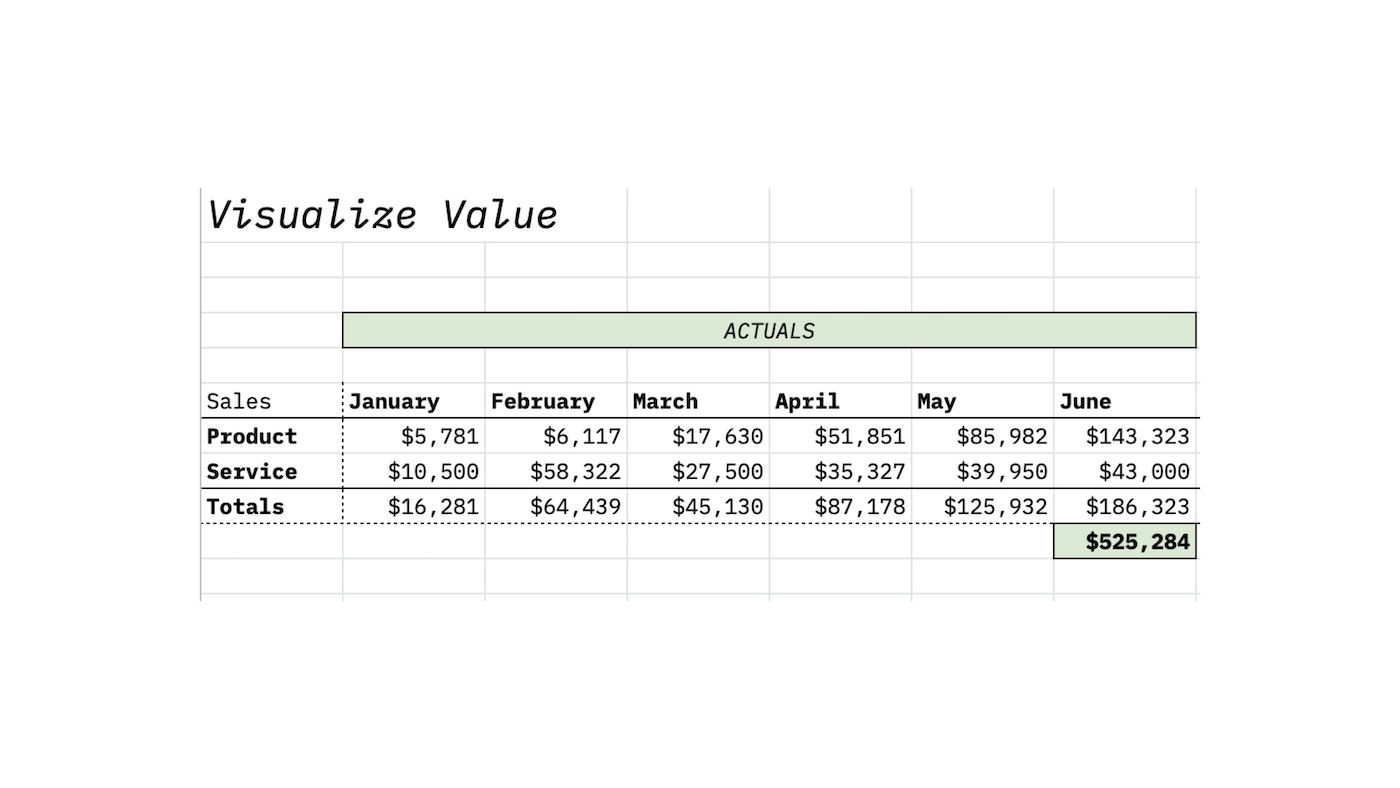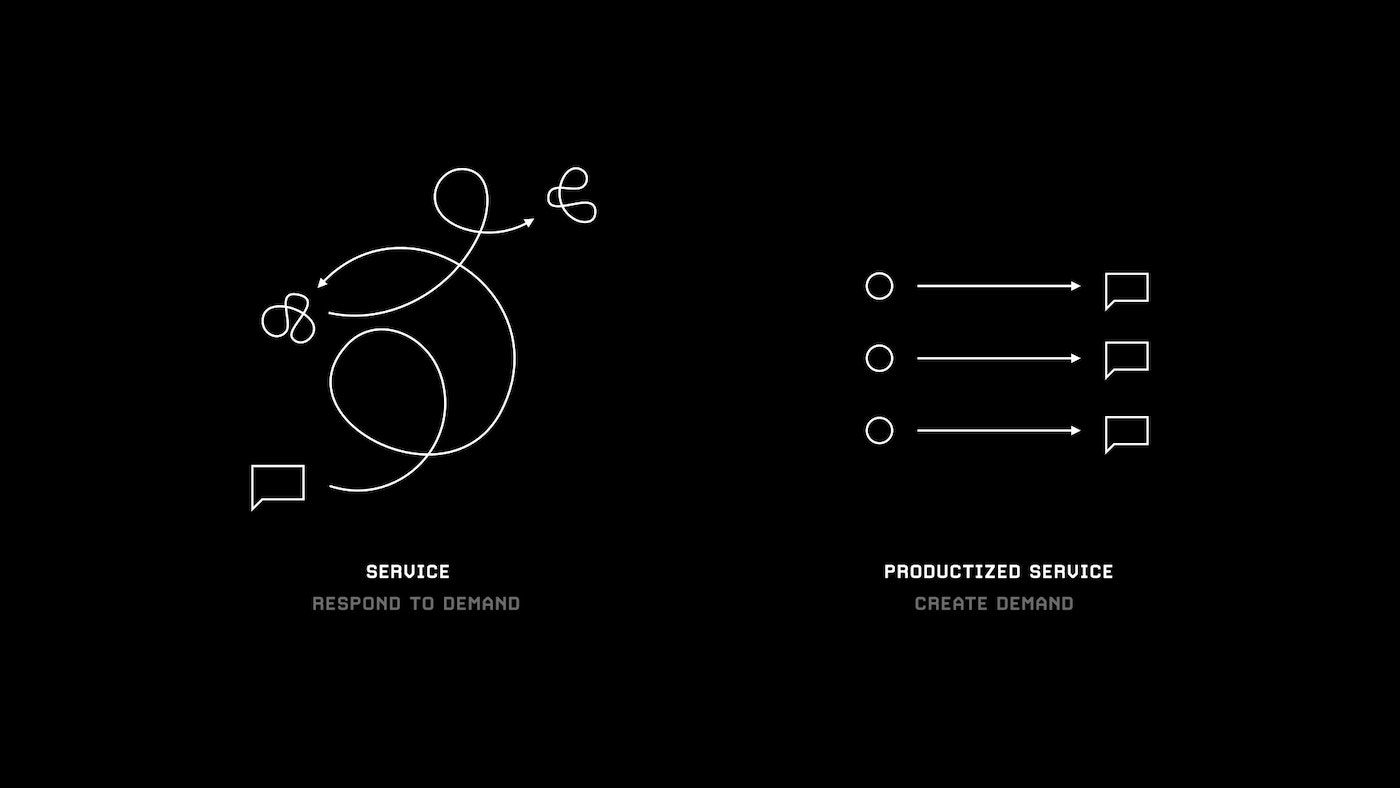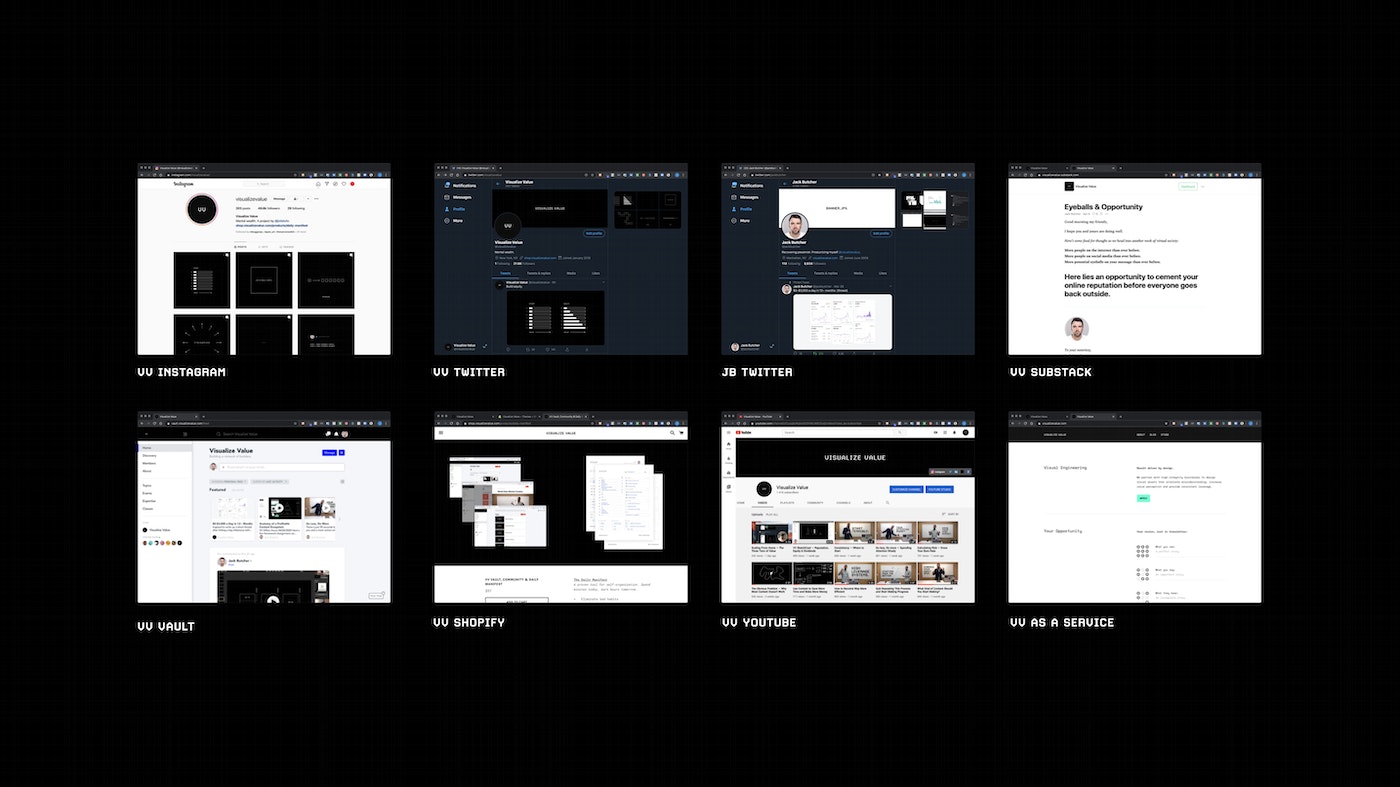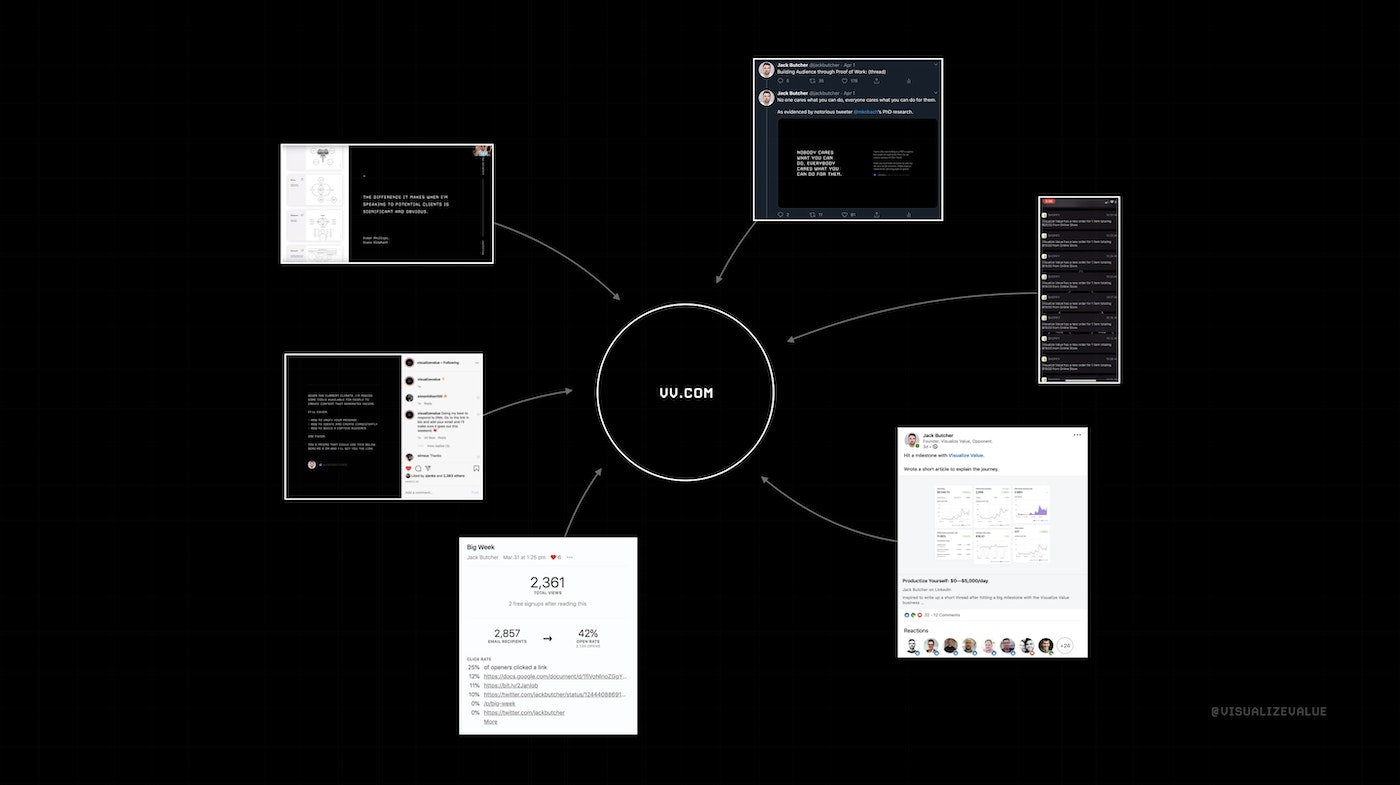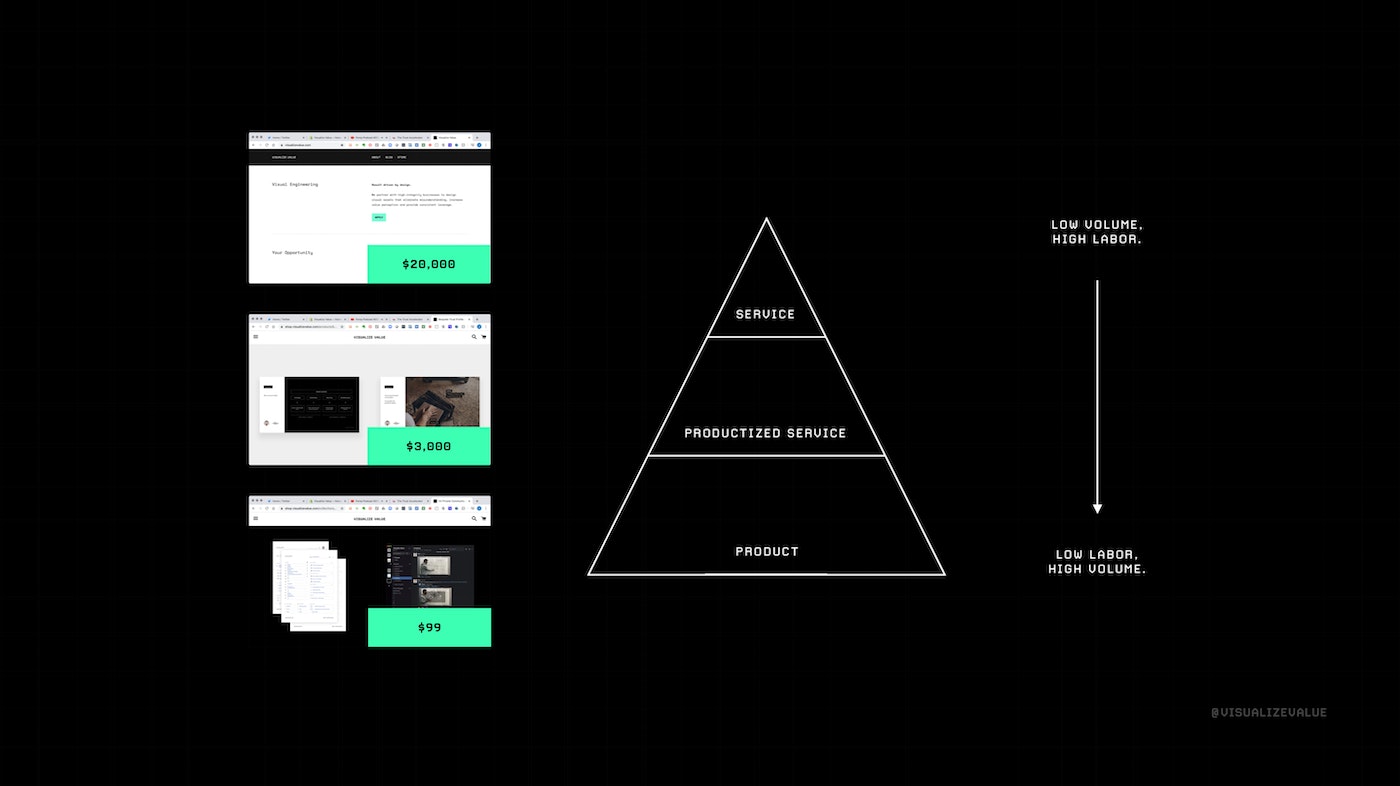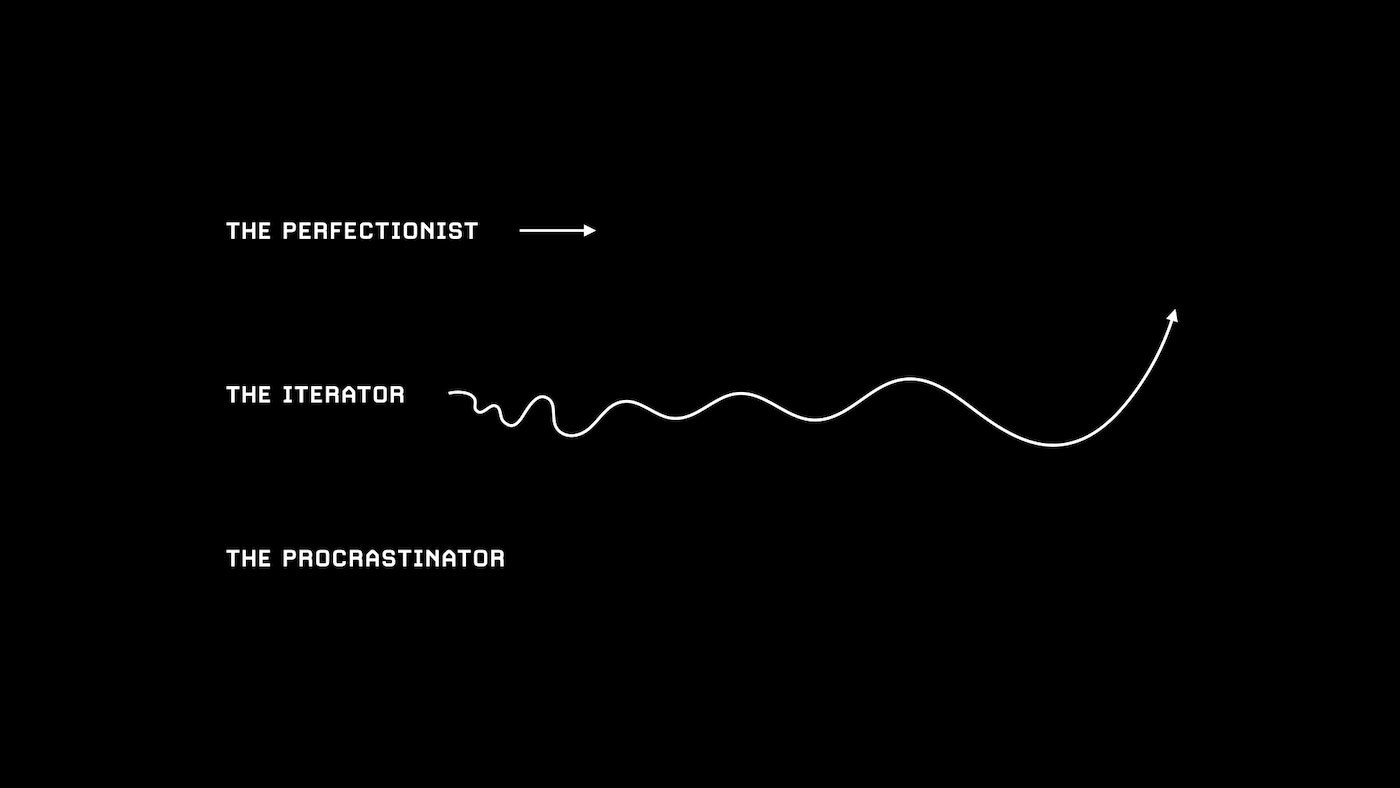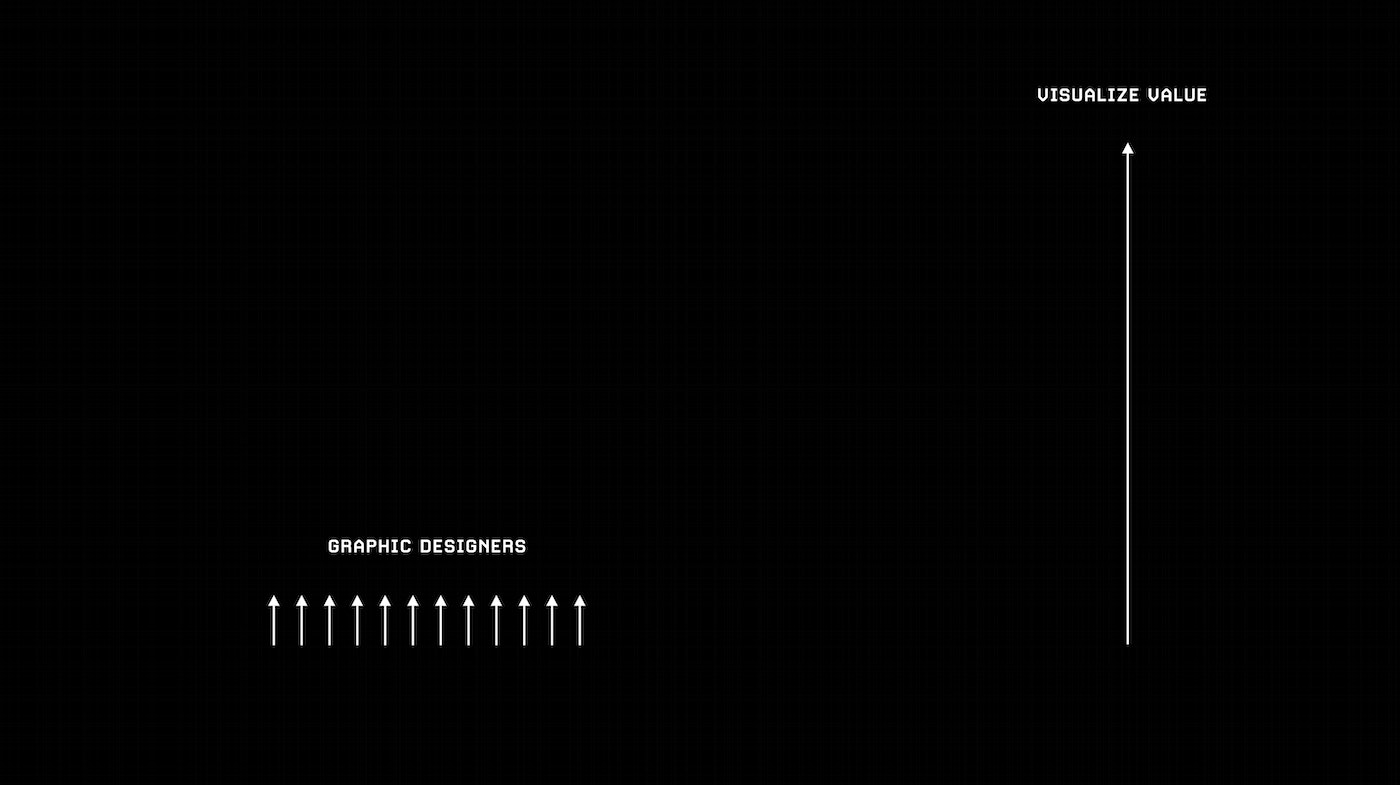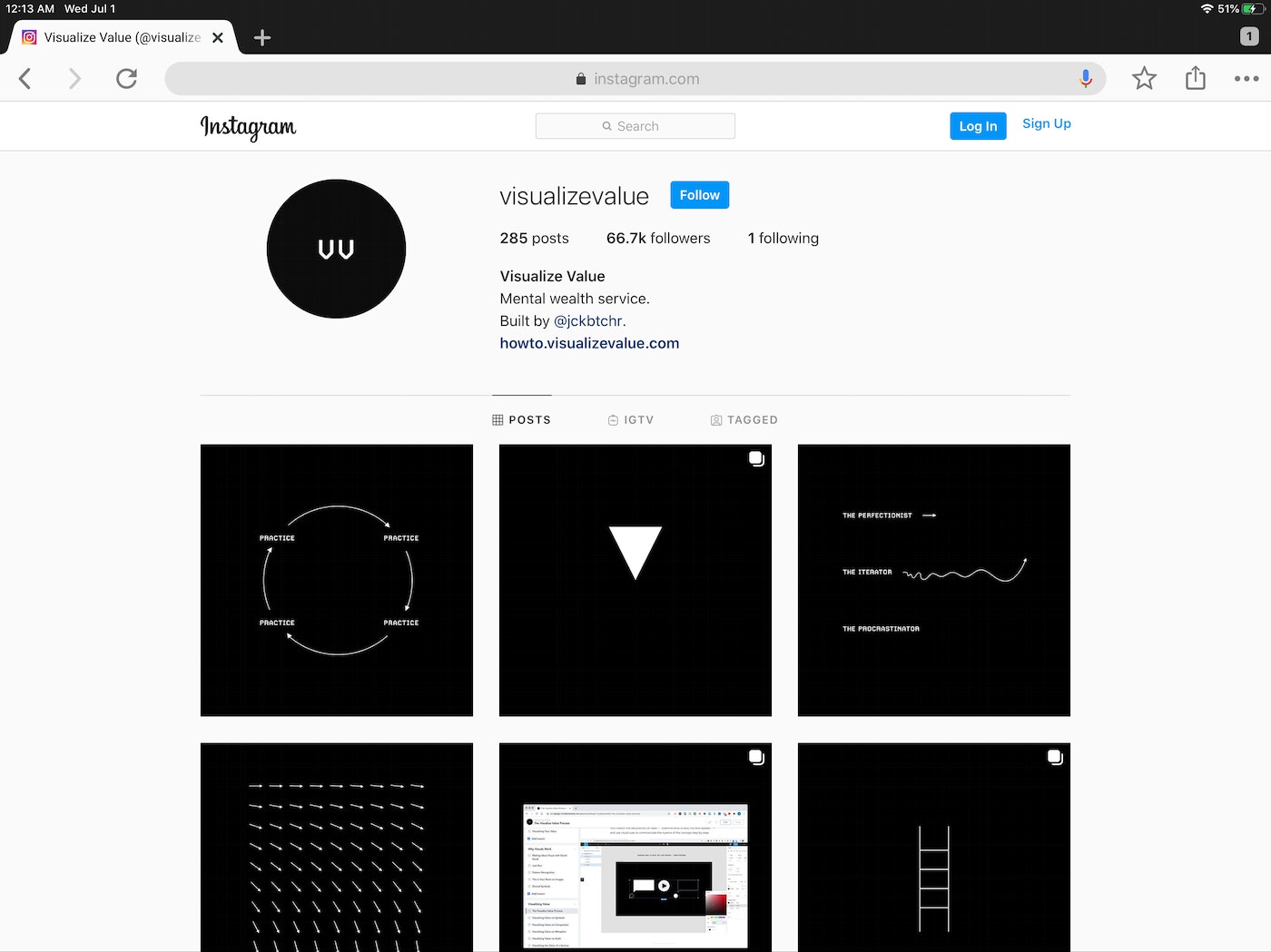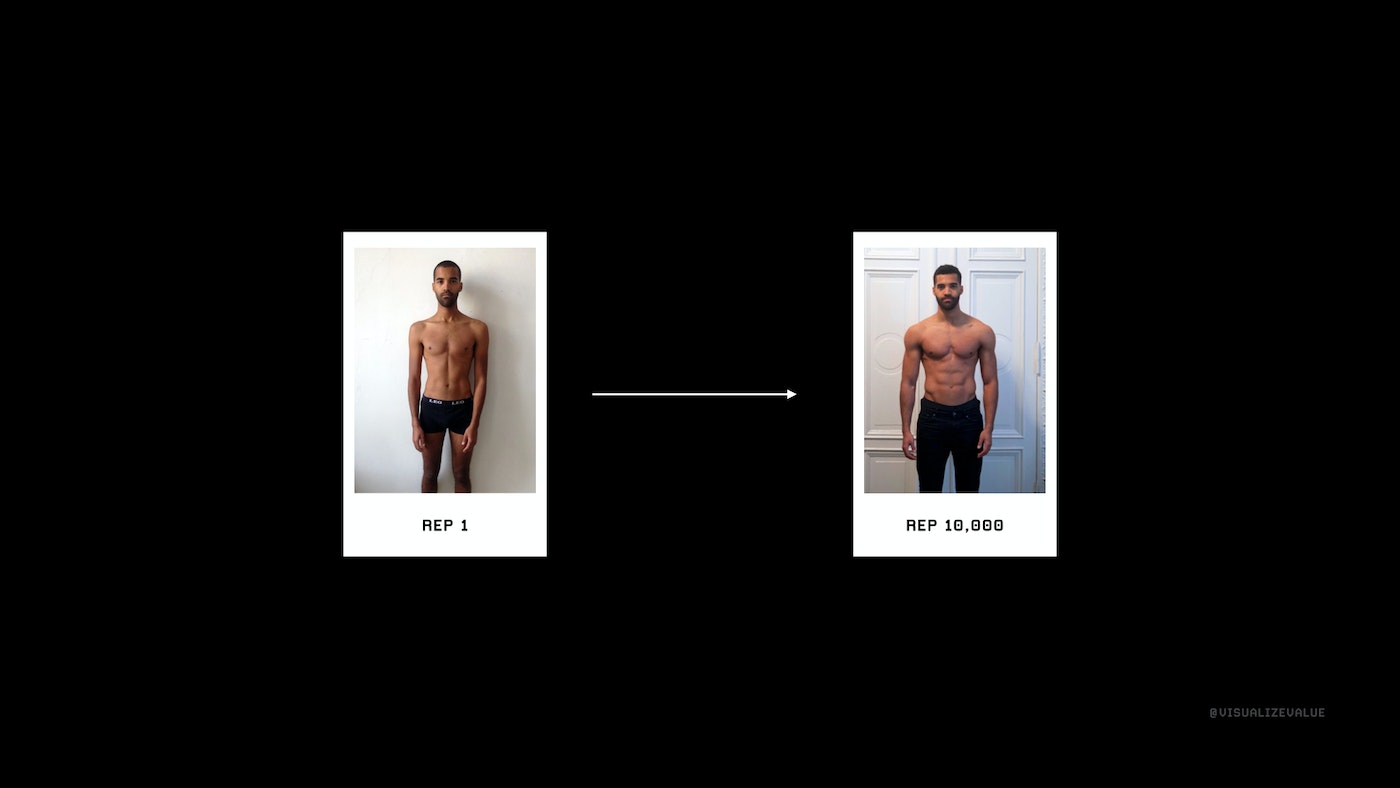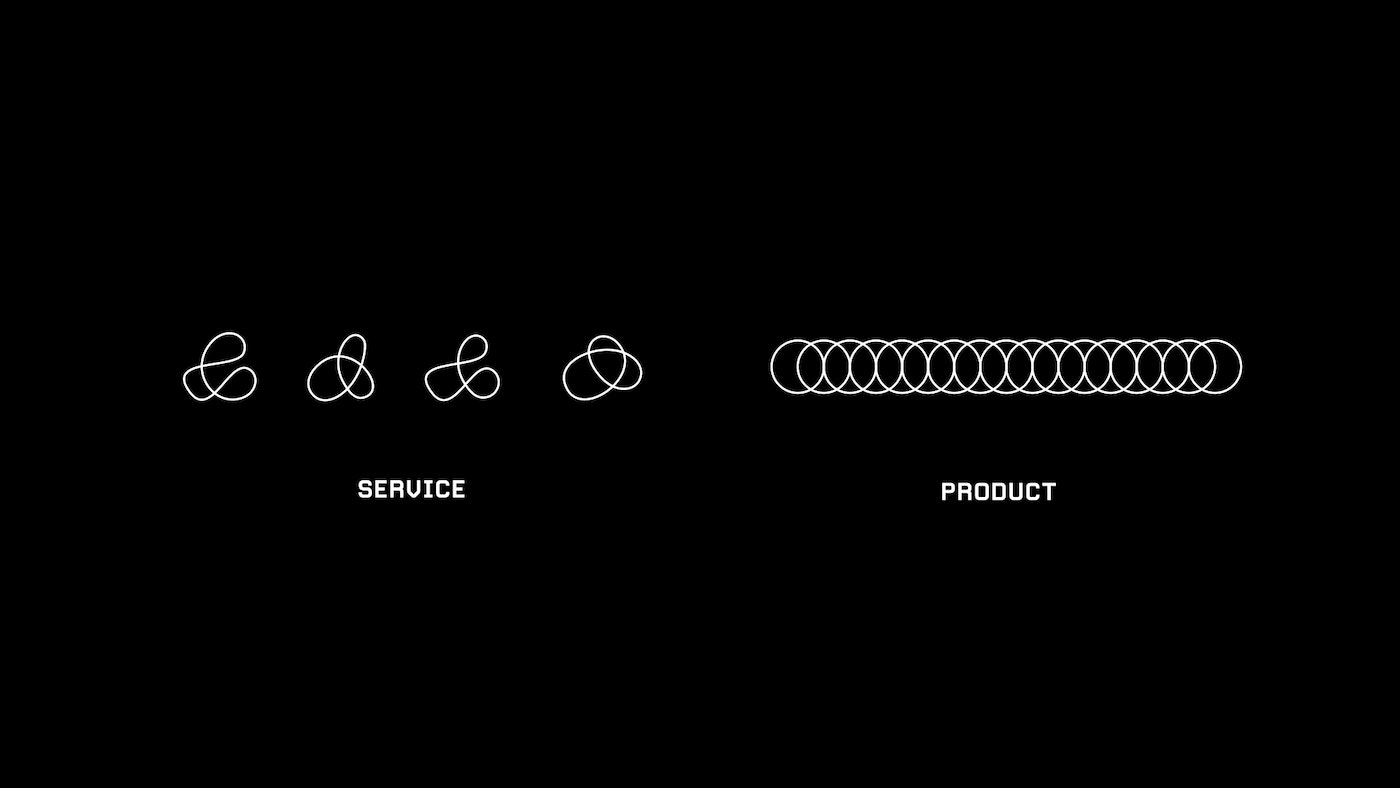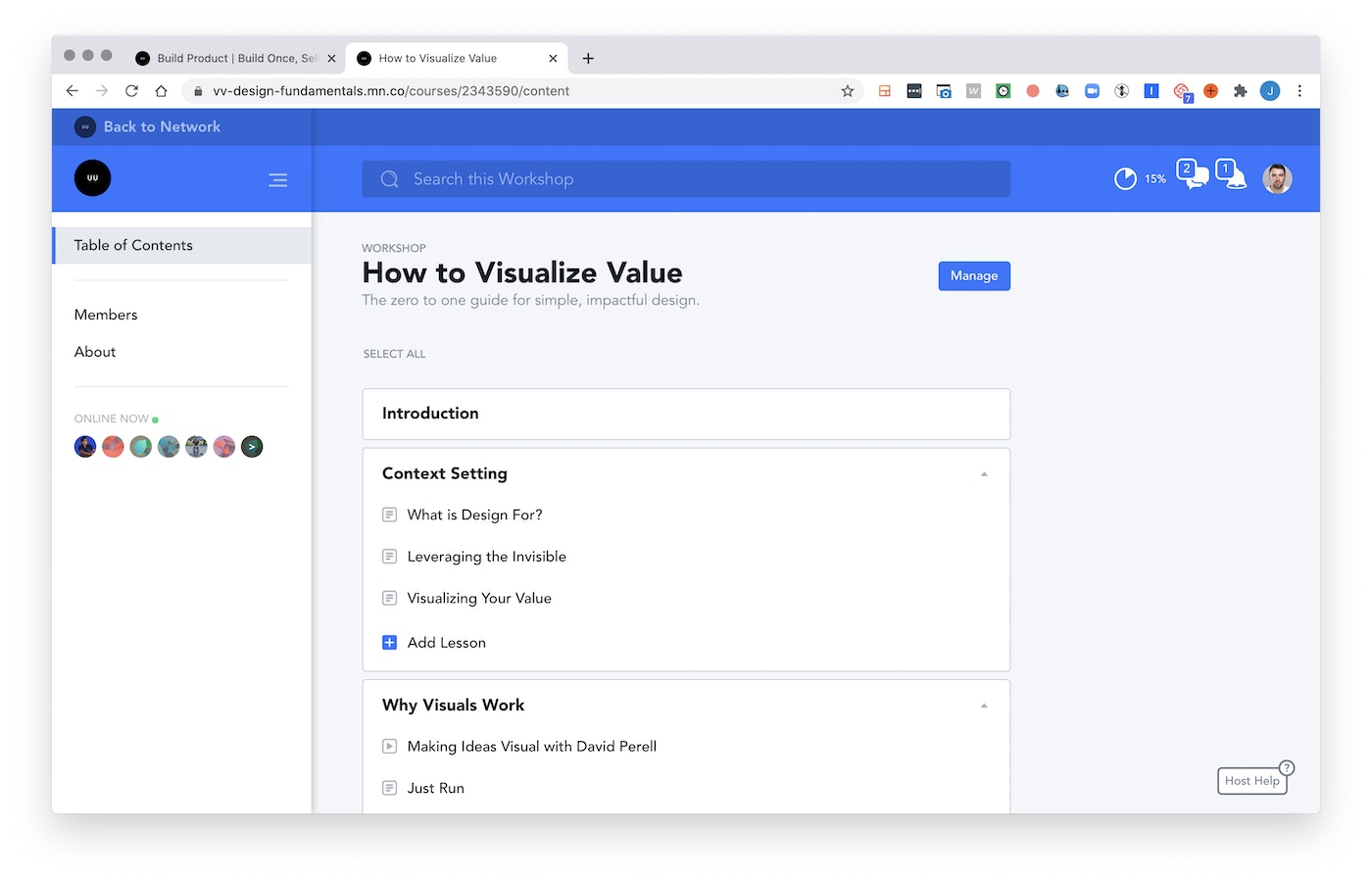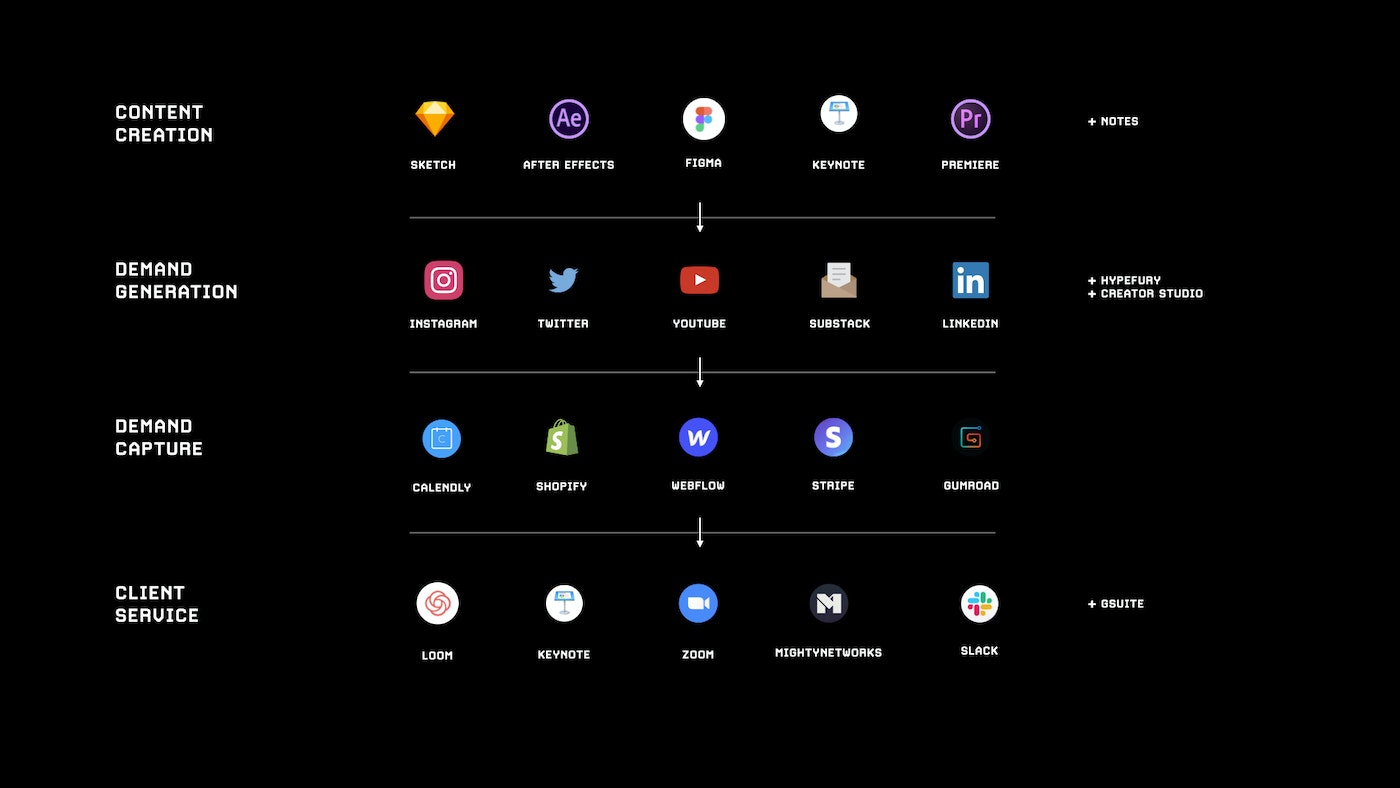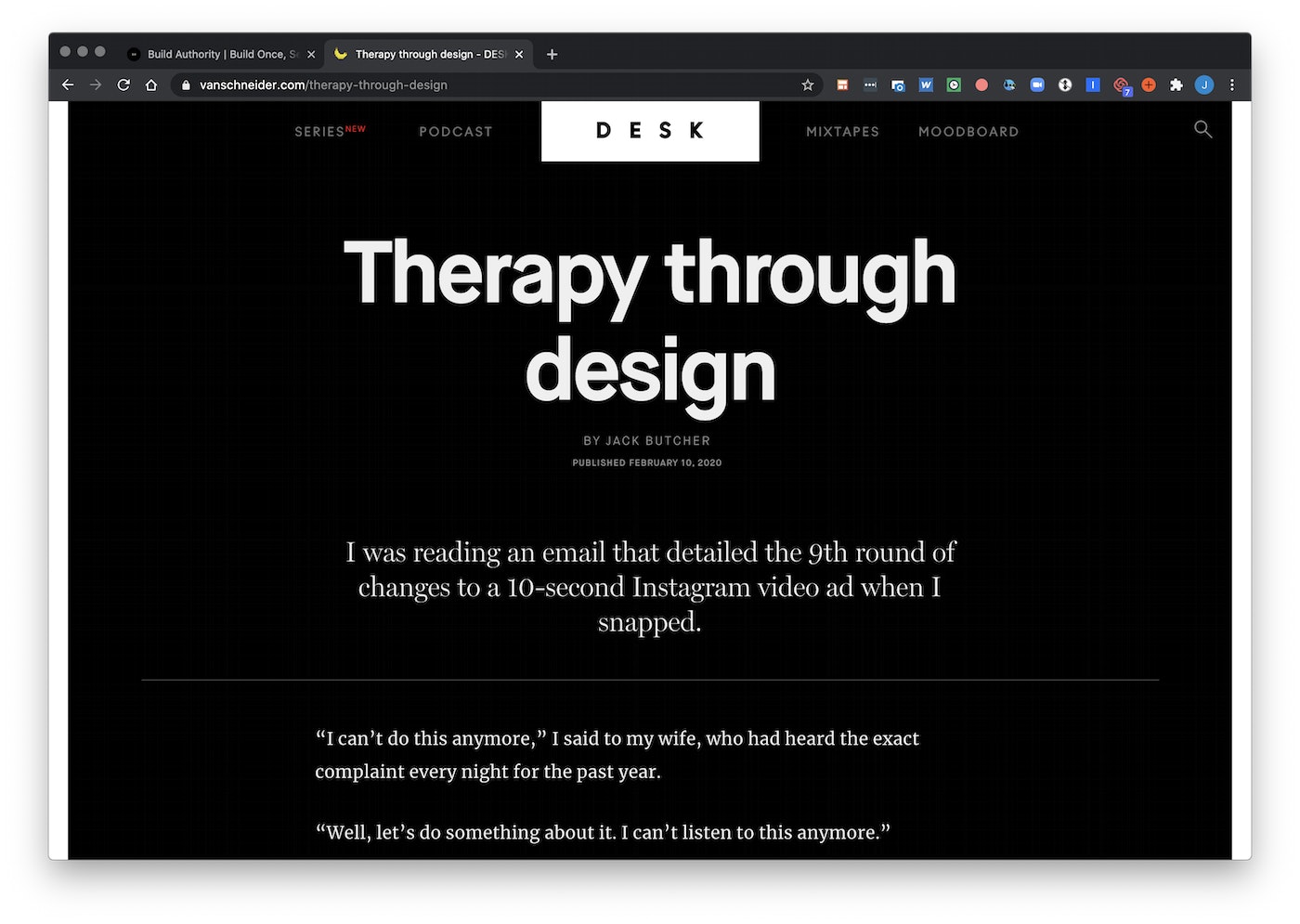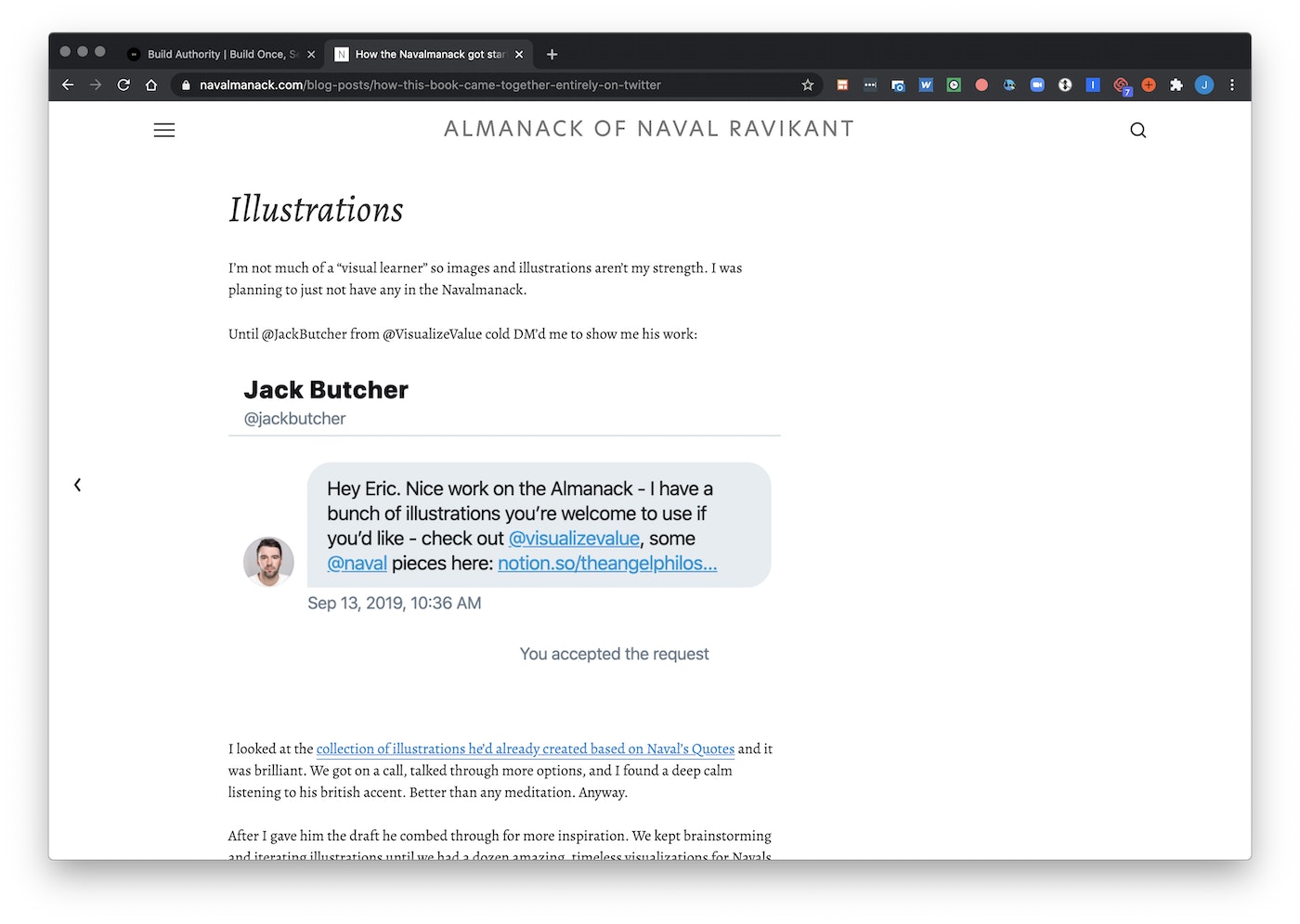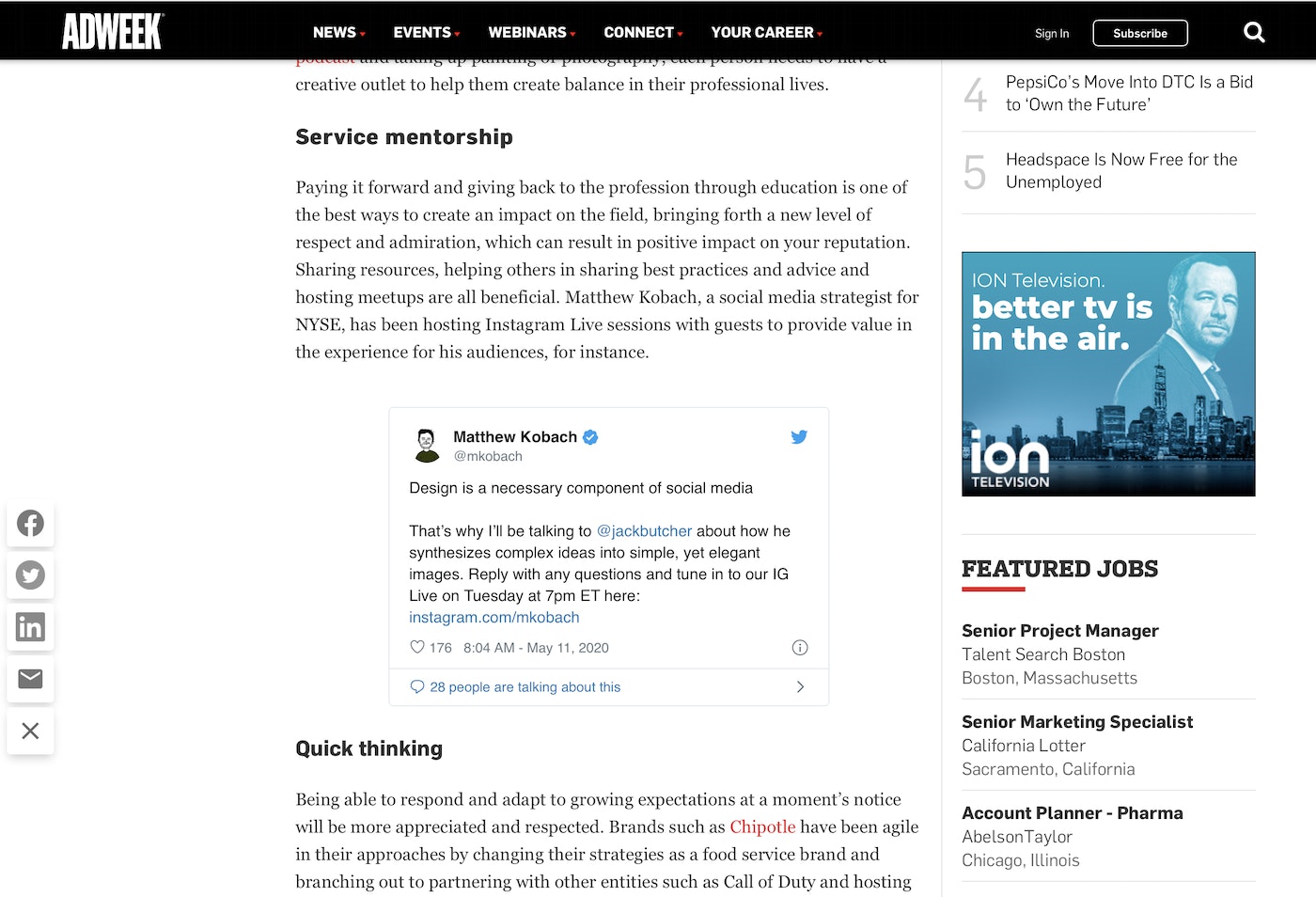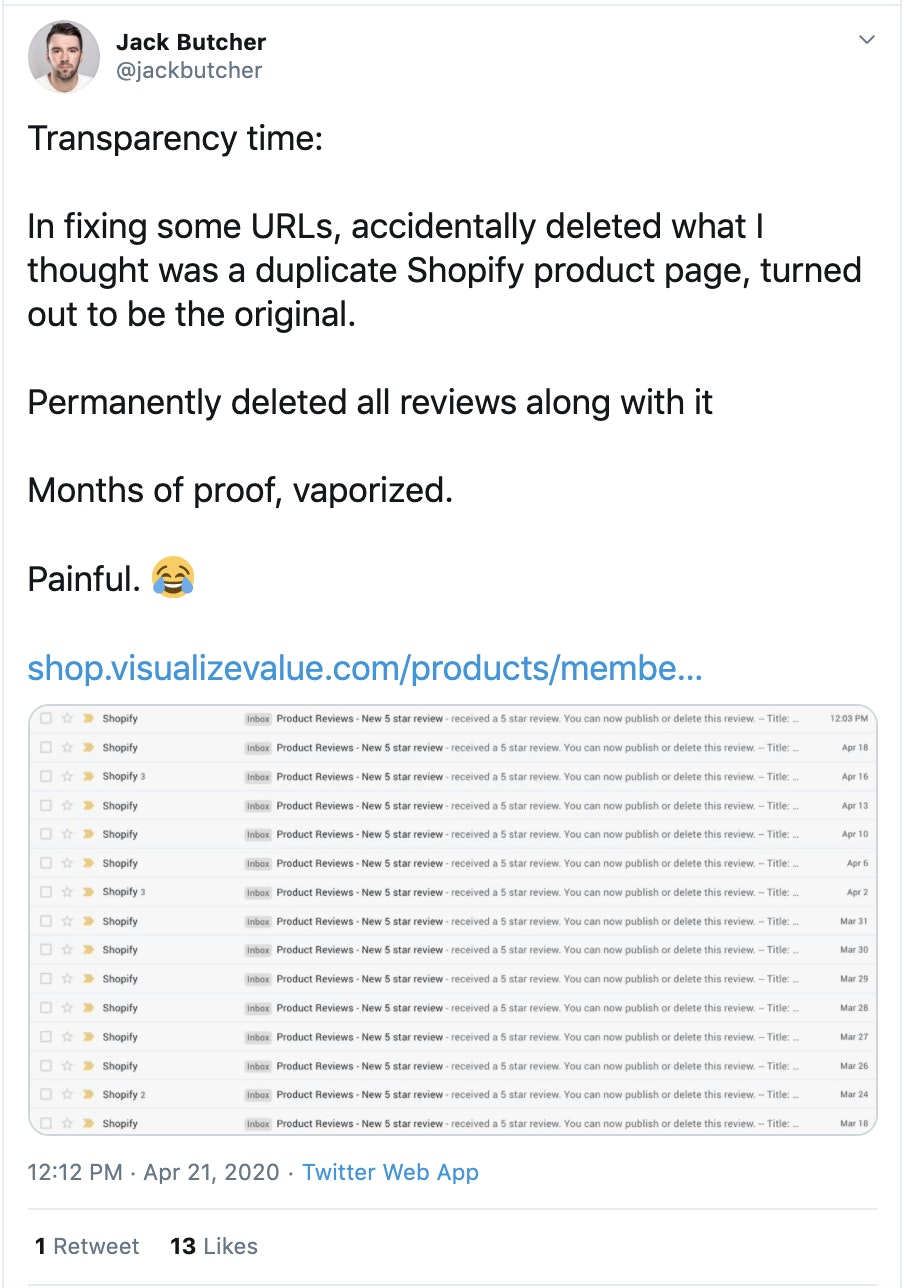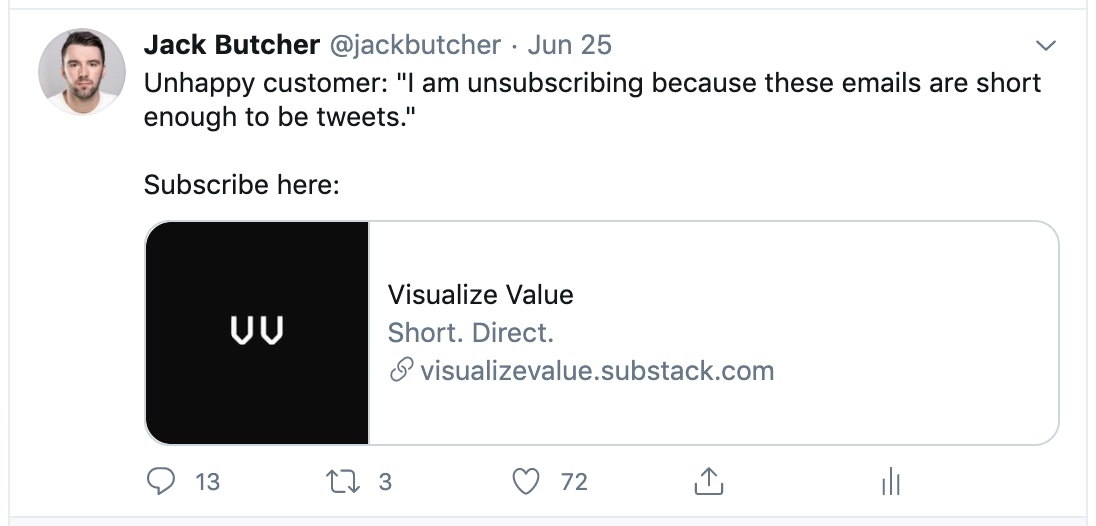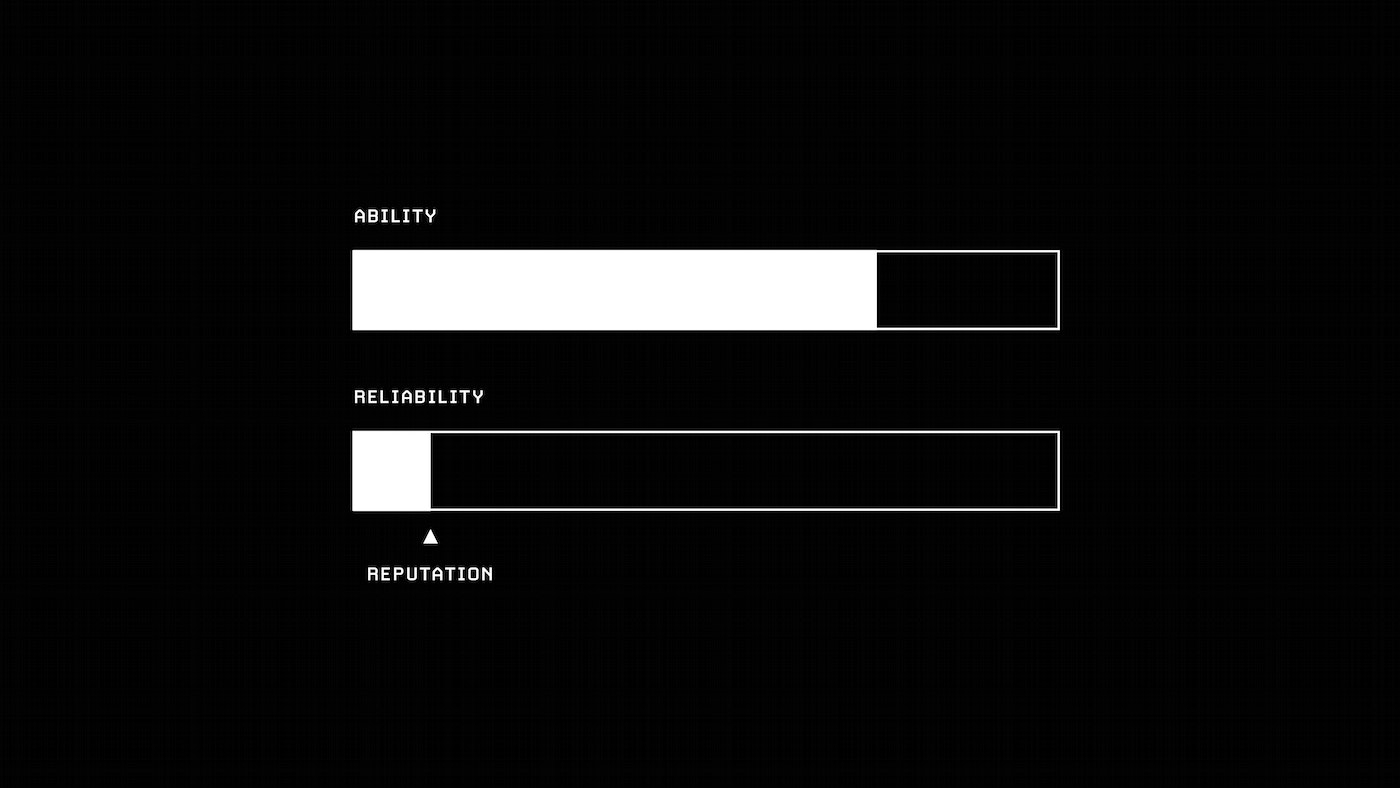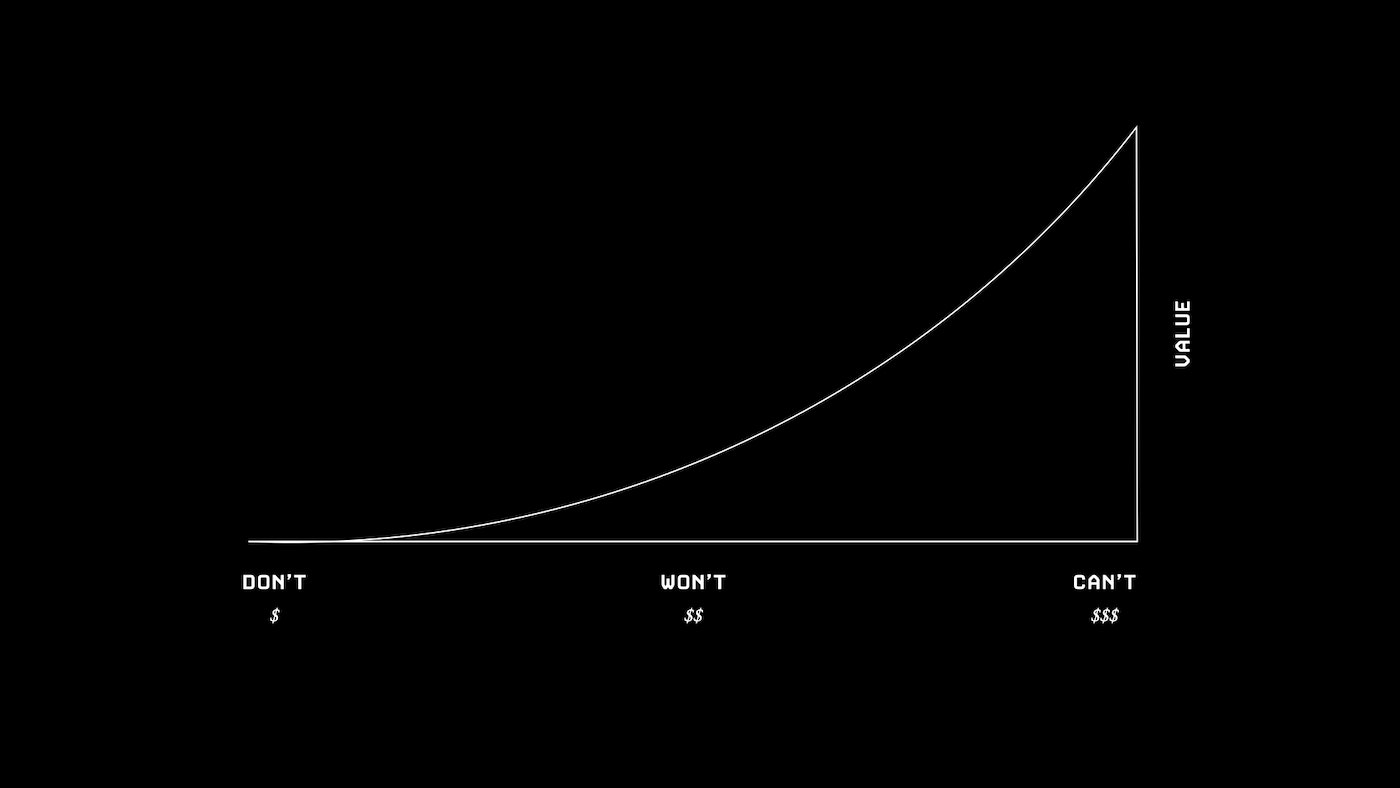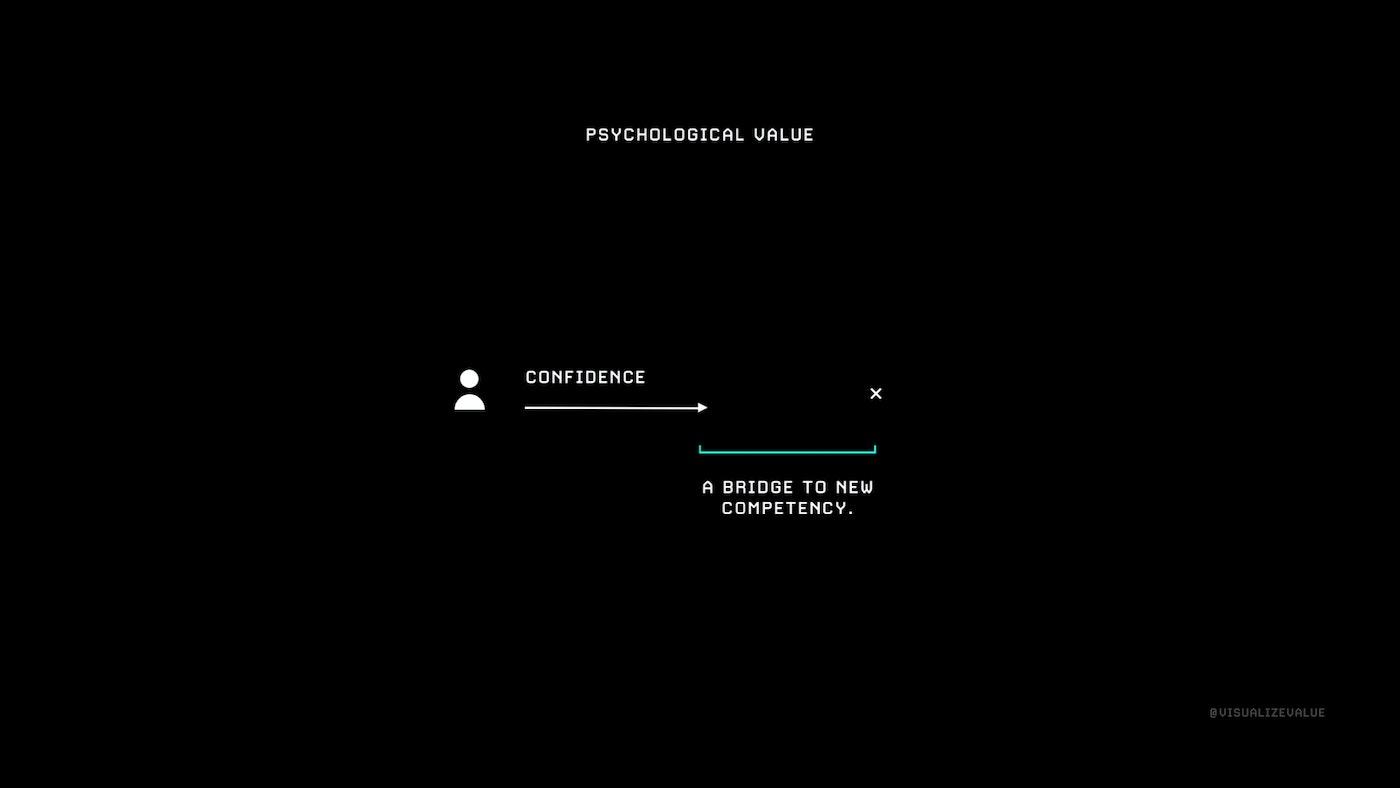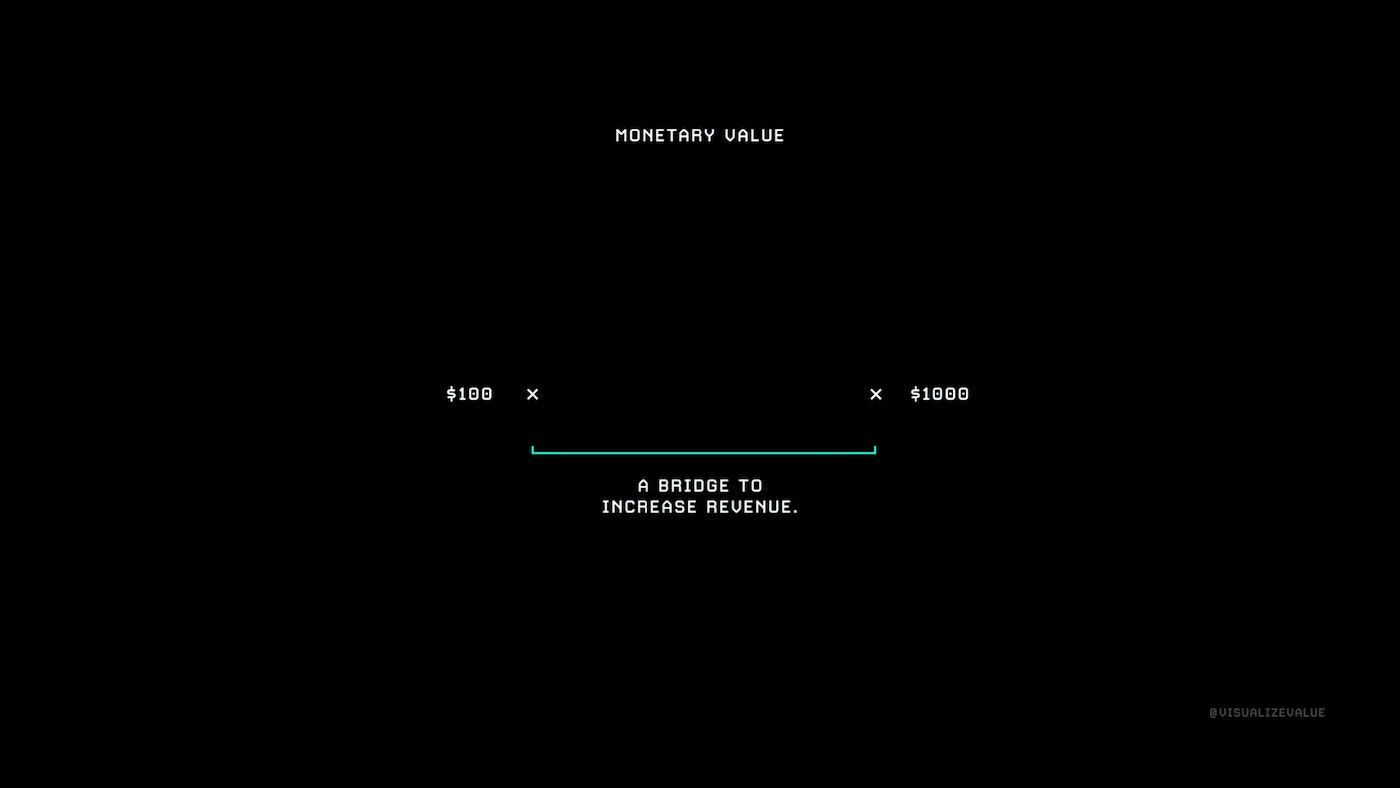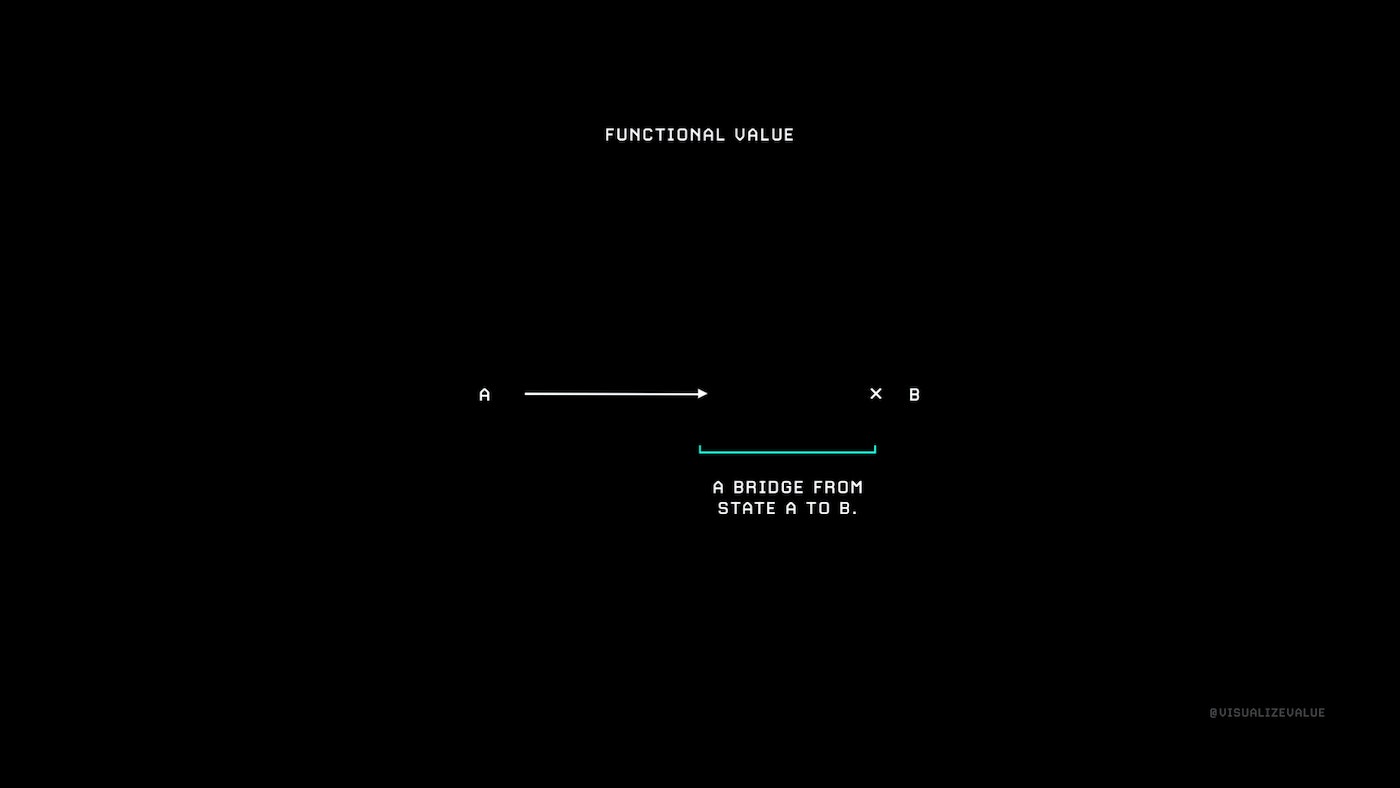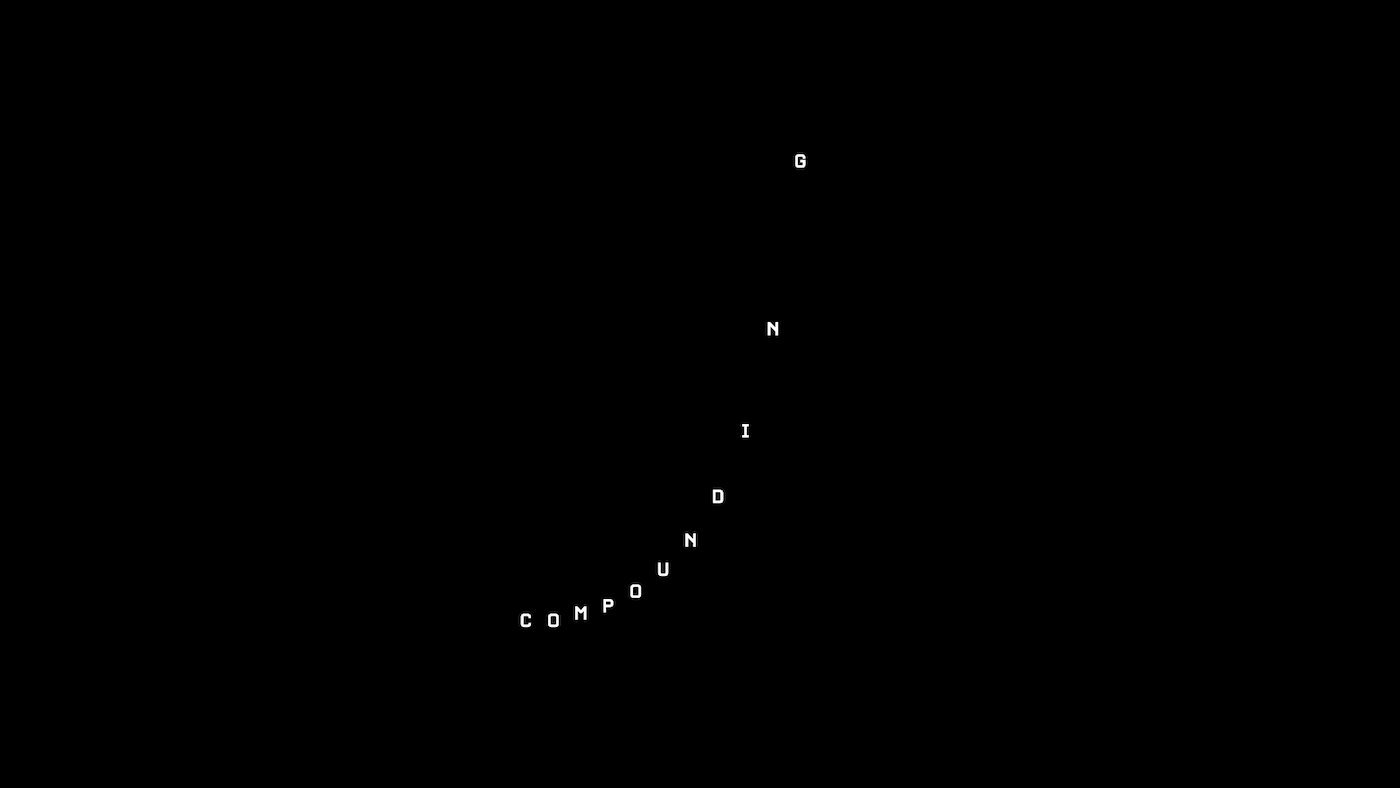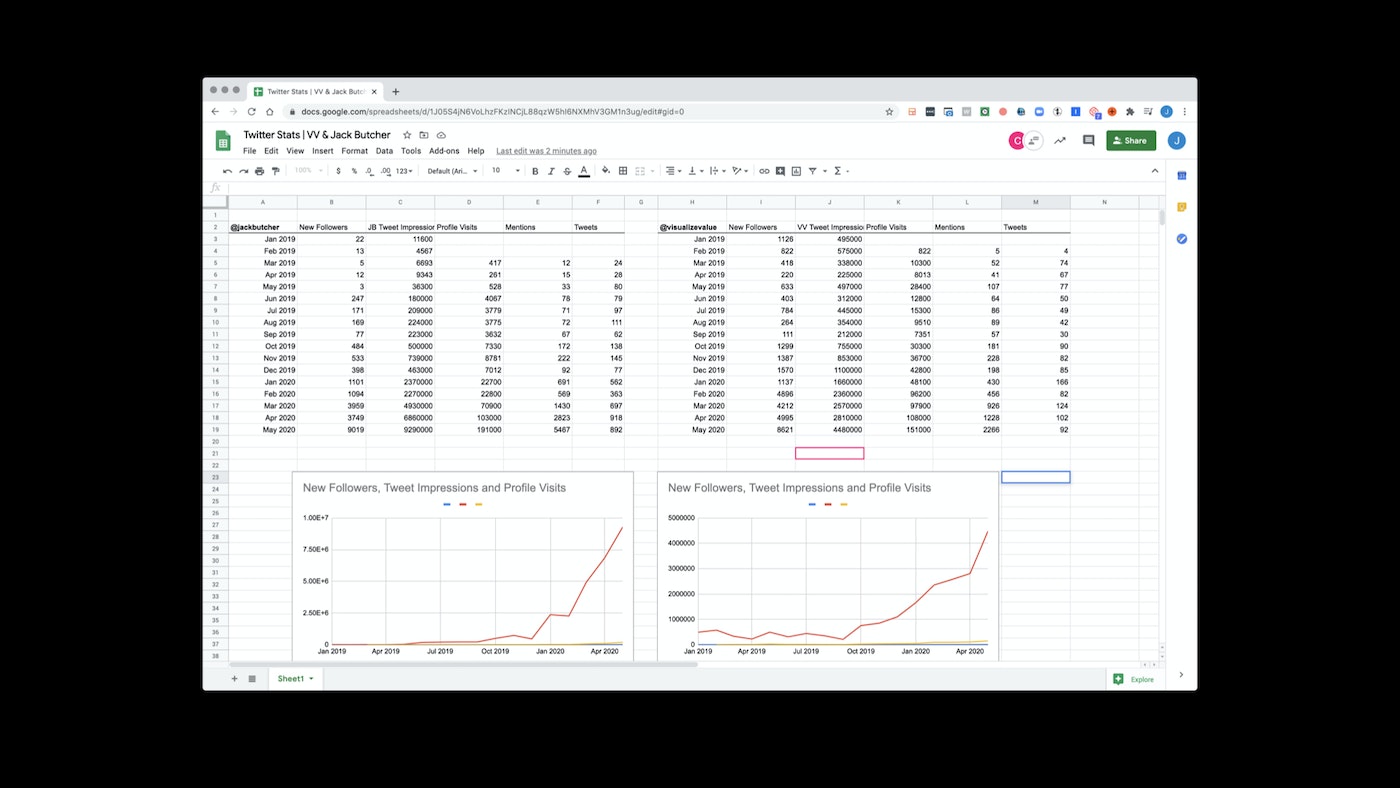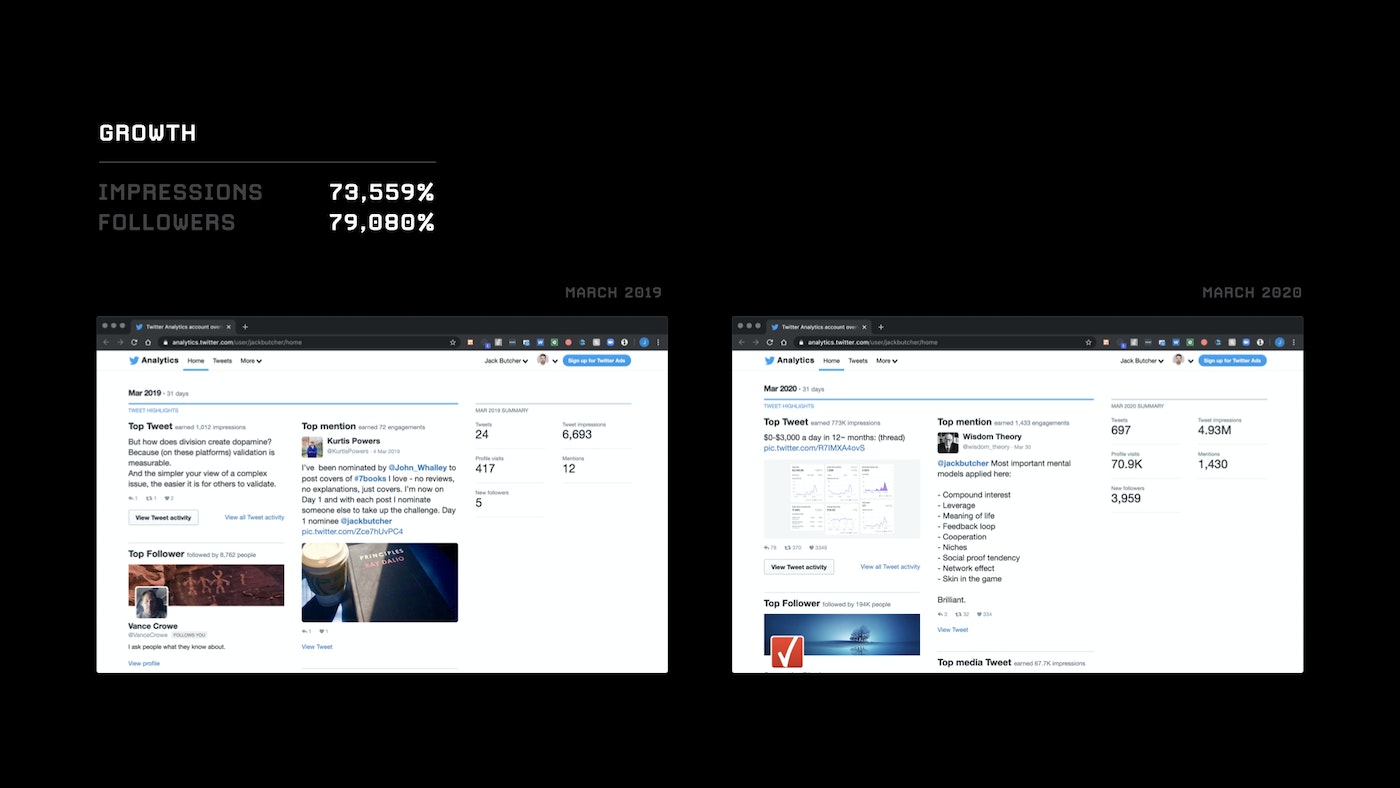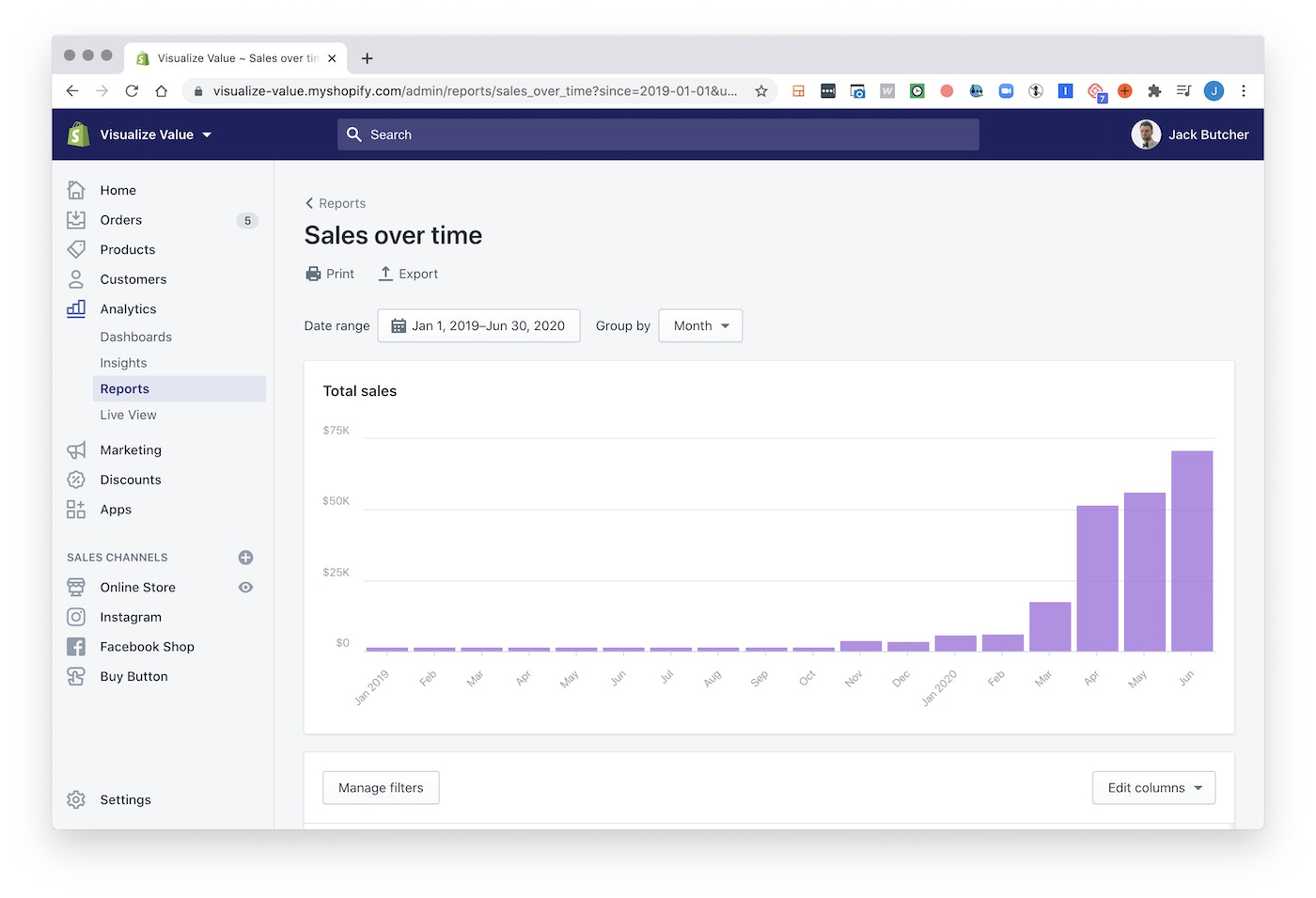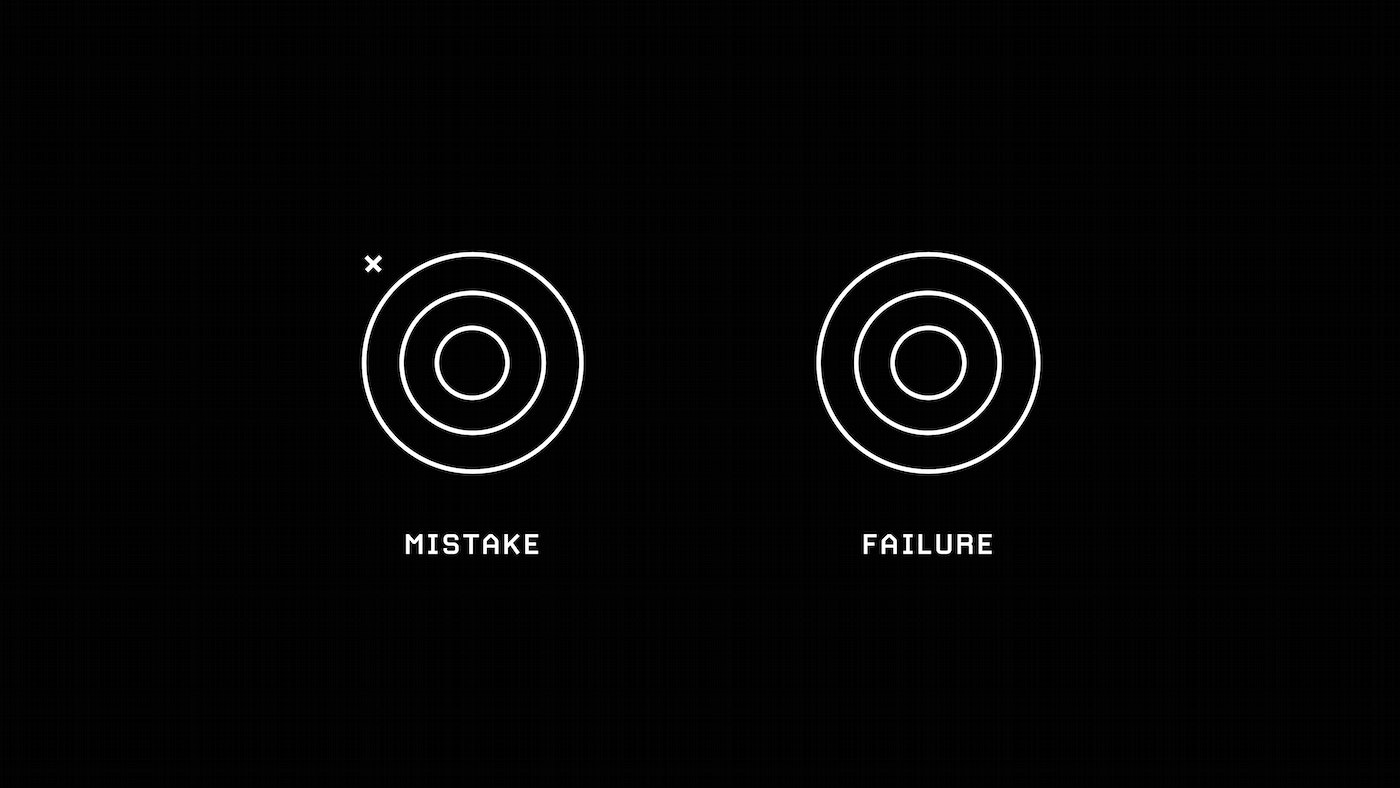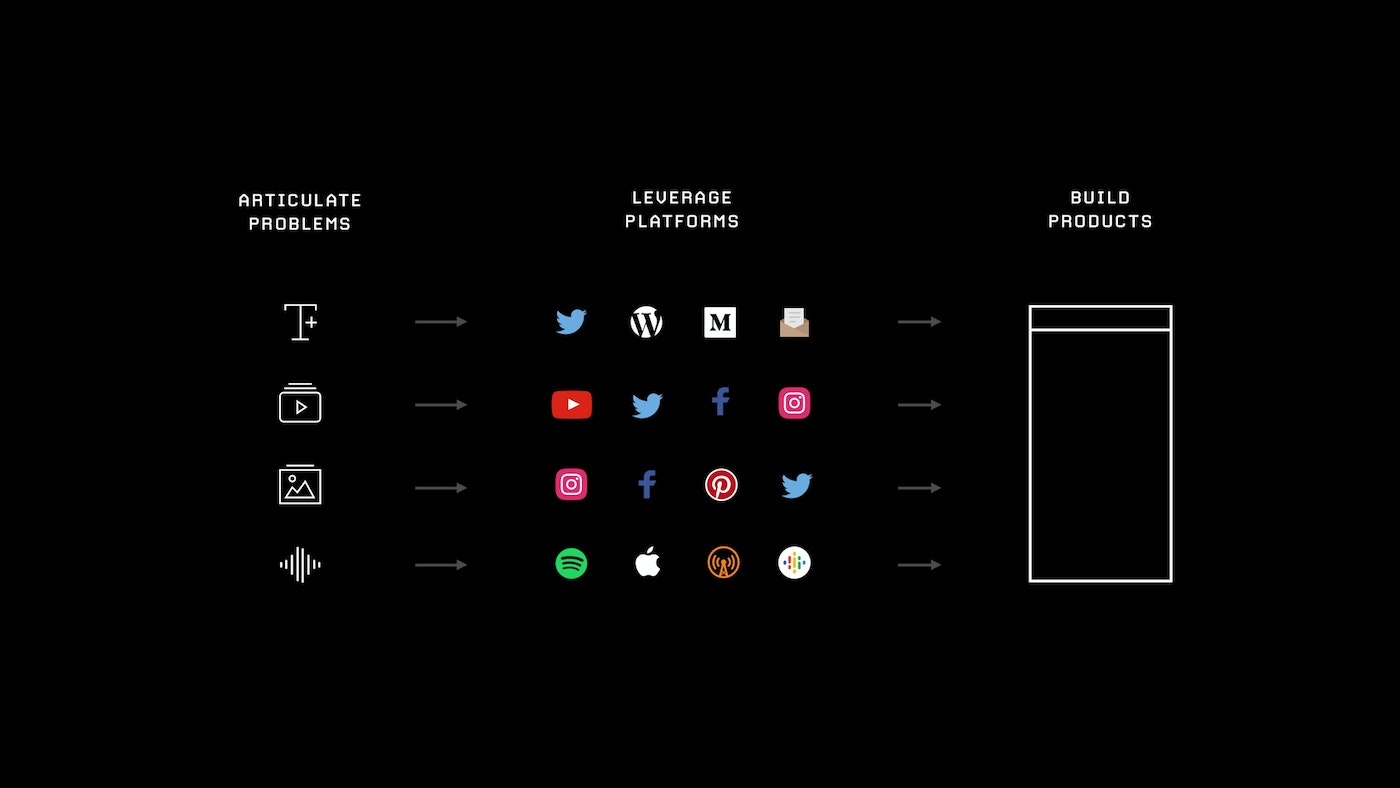Introduction
We’re here to turn your experience and skills into an asset that allows you to do work you care about and build a network that supports you financially.
To recap before we begin:
Who is this for?
To get the most out of this curriculum in the shortest amount of time, you’re starting with the following:
- You have specialized knowledge
- You generate results for your clients/customers
- You are comfortable promoting yourself
- You understand that results take time and effort
That said, I believe everything in here will be useful to you regardless of how many of the above points you can check off.
The Material
- How to productize a service business
- How to structure and build a digital training product
- How to build a product-centric content strategy
- How to leverage social platforms to scale
- How to collect social proof
- Developing a personal brand strategy
Build Once, Sell Twice
Welcome to the field manual for earning a living in the new economy.
What this course isn’t:
An exact formula for you to follow (that won’t work)
A dogmatic prescription of what to do (that won’t work)
A recommendation that you replicate my business exactly (that won’t work)
The entire premise of this course is centered around a simple but expansive idea that will change the way you think about your time:
The VV Story
Before we get into the course, I would like to set some context by explaining my journey to date.
I have spent a long time trying to figure out how to get into the position I am in right now - writing this to you, and take my responsibility of delivering what I promised very seriously.
It is my intention to extract the lessons I’ve learned from this journey and communicate them in a way that you can leverage them to build an asset you’re proud of.
Engineering Freedom
Build a reputation on the internet.
While there are thousands of business books filled with hypothetical strategies for building the next Facebook, I’d like to walk you through a process that you can use to find, monetize, and scale your specific knowledge as an individual.
It’s my belief that the business landscape will continue on its current trajectory, the big will get bigger, the small will get smaller.
Currently, 11.8% of commerce happens online.*
The other 88.2% is on its way.
The best strategy to take advantage of this trend over the long-term is to build a reputation on the internet.
For the individual, the risk is relatively low, while the potential upside is huge.
- 2020, census.gov
Executive Summary
The techniques, strategies, and tactics I will be referring to throughout this course are specific only to what I can prove with my experience.
Visualize Value is a remote business run entirely by my wife Celia and me.
As I explained in the introduction video — our previous business was focused solely on service (an advertising agency), and it was impossible for us to accelerate our income and free up our time, the more money we made the more miserable we became.
Below is a summary of our results year-to-date since pivoting our model to incorporate the things we’ll be sharing in this course. (Not pictured is 2019, where our service revenue was very similar, but our product revenue virtually non-existent.)
As you can see, our service revenue fluctuates dramatically, hitting a ceiling of $58,000 in February. Here, we’re constrained by the time we spend on client work in person.
However, since introducing product, we’ve been able to break the “time barrier” capturing more than 3x our service revenue, in less time, and with zero additional labor.
This is the nut we want to help you crack.
It is important to mention that we had no intention of burning the metaphorical “service boat” for a number of reasons. We still had clients to service, and we were not prepared to forfeit a solid income stream to gamble on a new business.
So how did we make this transition?
By narrowing our focus drastically. This is the trap I see most service business owners fall into — they assume that by getting hyper-specific about the problem they solve, they’re opting out of a wider opportunity. This would technically be true if the laws of the universe didn’t apply to you. If you are a human being though, it is a belief that will keep you stuck on the service hamster wheel forever.
If you want to escape, you need to create demand.
To create demand, we built a front-end asset that proves our capabilities to the market, builds audience, and slowly increases our reputational equity.
Beginning with Twitter, and expanding to Instagram, email (Substack), and YouTube, we make contact with the market every day.
This ecosystem of content plays two roles in growing the business:
- Driving up the value perception of the brand, ourselves, and our products.
- Seeking out and converting clients and customers automatically.
The traffic we generate across these platforms is driven to assets we’ve built that are designed to capture value.
1. Educating and qualifying clients for our consulting offer.
2. Driving customers to productized service and product ecommerce pages.
The tiers of our offering are as follows:
Service: VV Consulting ($20,000/mo)
Productized Service: VV Trust Profile Sprint ($3,000)
Product: Build Once, Sell Twice — The Productization Playbook ($499)
Product: How to Visualize Value — Design Fundamentals ($199)
Product: VV Community & Vault ($99/yr)
Product: VV Daily Manifest ($19)
Product: VV Wallpapers ($10)
This mix has delivered two distinct benefits:
-
Structured, enjoyable consulting work that exposes us to new problems and keeps us in tune with the needs of the market.
-
Product revenue that is disconnected from the number of hours we spend working.
In the remainder of this course, we’ll be unpacking the mechanisms that sit behind this ecosystem - everything that is obvious in hindsight but took an enormous amount of trial and error to realize.
Once again, thank you for being here. I hope you leverage these techniques to increase the quality of your working life, earn back your time, and make a long-term investment in growing your network.
Cheers,
Jack
Build Mindset
Building mindset is the crucial first step in this journey and a habit that must continue every day. It provides the foundation of pushing through when you feel like giving up.
How we think determines what we do, what we do determines where we end up. Simple enough, isn’t it?
Here’s a few short points on how to think about the upside of making yourself into an asset, and the mental barriers it’ll be necessary to smash through consistently.
Take responsibility
It’s on you to create an asset that’s going to look after you and your family over the long-term. It’s going to be uncomfortable, it’s going to be competitive, it’s also going to be worth it.
The potential downside of building a decentralized network of people that value what you do is low. The upside is huge.
Building your reputation on the internet is an asymmetric bet.
Take calculated risk
Embrace the risk that comes with trading under your own name. Put skin in the game and you will force yourself to get better. Engage in this pursuit with honesty and integrity and you will learn a great deal about yourself, the world, and other people.
Take control
You have nothing to offer until you get started. In the words of Naval Ravikant, “Learn to sell, learn to build. If you can do both, you will be unstoppable.”
You will experience failure.
You will experience embarrassment.
You will experience growth.
Most people are more reluctant to rely on a network of 4.5 billion people for their entire future than on one employer at a time.
You don’t need permission from anyone but yourself.
I didn’t need permission from anyone to sell you this product, I just posted thousands and thousands of times until you believed I had something of value to offer you.
And now, here you are. (And I appreciate you.)
So, understand that this is simply a game of iteration. The sooner you put yourself out there, the sooner you’ll get the feedback you need to grow.
Build Skill
The value of everyone’s time starts at zero.
Always remember:
Nobody cares what you can do, everybody cares what you can do for them.
For a hard-hitting perspective on this, read this article.
Learn by experience
Everyone acquires knowledge via experience.
The skills we pick up working a job, following our interests on the side, or studying for specifically.
At this stage, we’re still responding to demand.
Investing our time to build skills that the market values until we’re confident enough to sell them independently.
It takes years to acquire knowledge specific enough to be productized.
In the end, the more unique your experience, the more valuable your product.
Understand the above and you can reframe what you’d once think of as wasted time as a necessary investment in becoming unique.
For context, I stumbled upon the concept of productization long after I’d spent many years accruing a random selection of skills and experiences - and deployed them against many different types of problems.
If you’re just getting started, you can do what I did (get paid to learn on the job), or you can circumvent the market by building skills off the job (get paid and learn on the side).
Learn by iteration
Remember, everyone you admire was once a beginner. The unavoidable first step in creating something valuable is creating something worthless.
It’s a privilege to fail in public.
When you’re operating with skin in the game, you’ll be driven to iterate forever.
Think of your working life as simply a series of experiments, because it is.
Learn by helping
Make others successful. Pick up skills in application and start to get a feel for where you add the most value. Eventually, you’ll generate results and other people will see value in your skills.
Learn by building
Permissionless projects = permissionless progress.
The internet makes it possible to build projects in public to validate demand.
Visualize Value didn’t begin with a very specific business plan, it was simply a curiosity (philosophy, business, mindset) combined with a set of competencies (branding, design, marketing)
Remove yourself from the consideration set of other practitioners by putting your extremely specific point of view out into the world consistently.
Curiosity drives competence:
Let’s say you want to learn graphic design and you love basketball.
Commit to a project where you design a piece of media every day breaking down a basketball player’s last performance, or a coach’s philosophy, or a team’s history.
By publishing this work, you build an audience of:
Sports fans/brands (to sell design services to)
Aspiring graphic designers (to sell scalable product to)
Or, let’s say you’re a financial planner and you love entrepreneurship.
Commit to a project where you articulate how different business models impact the long-term financial picture of an entrepreneur and their family.
By publishing this work, you build an audience of:
Entrepreneurs (to sell financial planning services to)
Other financial planners (to sell scalable product to)
Build Process
Your skills are valuable, but so are everyone else’s.
Now your job is to package your unique skills, perspective, and interests in a way that generates exclusive demand.
Regardless of what you’re selling, the three steps below are a universal formula for creating demand and positioning yourself as the solution to the demand you’ve generated.
Make content that points out the problem.
Make product that provides the solution.
Prove the problem
Your ability to provide service is dictated by your ability to position yourself as the answer to a problem. Not all problems are colossal.
Think back to the don’t, won’t, can’t idea - get experience from doing things people don’t want to do, expand into what they won’t do, and end up doing what they can’t do.
“The world doesn’t reward people who are the best at solving problems, it rewards people who communicate problems best.” — David Perell
Your ability to articulate the problem is as important as your ability to solve it.
One more time for the people in the back:
You can only solve the problems you can articulate.
Prove the process
“A problem well-articulated is a problem half solved.” — Charles Kettering
The other half of the problem is designing a process that makes it possible for you to solve that well-articulated problem for lots of people.
Step 1: Communicate the problem well.
Step 2: Communicate the solution well.
The real beauty in this part of the puzzle is that you don’t need anyone’s permission in order to prove your ability to the world.
Set yourself a hypothetical exercise and make something real.
Prove yourself (the solution).
People trust people. Gather proof that your service is delivering the result you promised at every opportunity. You can measure the quality of your solution based on the amount of friction between you and the collection of social proof. If you have to beg for it, go back and improve the product.
If people give it to you voluntarily, go out and tell more people:
Build Reputation
We’re fortunate to have the opportunity to build a network of people around our ideas, interests, and abilities, regardless of where we are physically.
The long term goal of cementing your unique reputation is to escape competition entirely:
“Anyone can make their own whiskey, but only Glenfiddich can make Glenfiddich.”
Here’s a compilation of ideas that are foundational to scaling your network on the internet.
Be deliberate.
Make noise, listen for signal.
When you start getting signal, double down. Focus on substance and accelerate your output cycle.
If you want to be recognized by the market, be deliberately recognizable.
“Good advertising wears in, not out.” — Jon Lombardo
Be assertive.
You now have confidence and permission from the market to make yourself prominent and visible in your specialty. The market will reward you for convincing people you’re better.
Speak in statements. People will only trust you to the degree you trust yourself.
Be impervious.
When you reach a certain scale, criticism and imitation are inevitable. Embrace both. They’re signals your audience is growing.
Opinions are required for markets to function. Realize this and you will stop taking things personally.
Be prolific.
Find 1,000 ways to say the same thing. Constantly show people what you’re doing. Your audience should feel like you’re everywhere they look.
Be open.
Take people behind-the-scenes and continuously sell your sawdust. Prove you can solve specific problems by showing how you do it. Give away your “secrets” and people will pay you to implement them.
Be yourself.
Too often, marketing is a firewall we put up to protect ourselves from the market. The closer you can get to your natural state in your communication, the better insulated from the competition you will be.
This is extremely uncomfortable at first, but well worth it over the long-term. After all, people buy from people.
“A company is successful to the extent it does something other companies can’t do.” — Peter Thiel
With that in mind, the growth vector for a company where you are the asset is hugely influenced by how authentically you behave.
“Escape competition through authenticity.”— Naval Ravikant
There are a million courses, YouTube channels, podcasts, blogs, websites, books, events, and trainings on building online businesses, but you’re here watching this one.
Why?
Build Product
At this stage of the journey, you’ve increased the value of your time, but there’s a limit to what you can do. Now, it’s time to leverage your reputation and specific knowledge into a profitable asset you own, and can sell infinitely with zero cost of replication.
Design for a result.
Design a product around a result you’ve delivered repeatedly.
After proving our ability to translate concepts into visuals to build an audience of over 100,000 people, generate $80,000 in consulting revenue for ourselves, and many multiples of that for our clients, I was confident in my ability to help others learn the skills behind the result.
How to Visualize Value — Design Fundamentals was born.
Design on internet infrastructure
Build it yourself
Today, you can use technology to construct a digital business without writing a single line of code.
Here’s what the Visualize Value tech stack looks like:
How it all fits together:
Content creation:
We create Visualize Value graphics with figma.com, Keynote, and After Effects.
Demand generation:
Those assets are distributed on Instagram and Twitter, and leveraged into YouTube videos and longer-form emails. As the audience grows, we drive more traffic into our Demand Capture layer.
Demand capture:
Traffic from social platforms and emails lands here. We use Shopify to host our consumer products and a custom-built webflow page to explain our consulting services. We use calendly to set up calls for our consulting services.
Client Service:
The final layer of the tech stack is comprised of the tools we use to service clients. MightyNetworks is where we host our courses, and our community runs on Slack and Zoom.
Promote yourself
This goes without saying, but I’ll say it anyway. If you are not competing for attention on the internet, you are opting out of the largest captive pool of attention to have ever existed in human history.
There’s asymmetric upside in producing media that communicates your skillset to the world. Tweet, record podcasts, make videos, and write.
Design systems that scale
Spend 20 percent of your day building systems to handle what you do with 80 percent of your day. The more you build systems that solve persistent problems you encounter, the more valuable your time will become.
Build Authority
People don’t buy your product, they buy you. Play the long game.
Own your reputation
Build mutually beneficial relationships on top of your unique assets and abilities. Collaborate with people who compliment your skillset.
As your network grows, and your reputation increases in value, so do the participants in your network, and by extension, the opportunities you have access to.
As this compounds, you can become more and more selective in the opportunities you choose to pursue.
Own your failures
When you mess up, own up. “Your reputation takes years to build and five minutes to destroy.” — Warren Buffet
I have made a few mistakes in growing the Visualize Value business.
Play Video
On each occasion, owning up and asking for forgiveness has resulted in some of the most incredible bursts of growth we have seen as a company.
With ultimate transparency comes a higher degree of risk, respect your network like your livelihood depends upon it, because it does.
Own your story
Wrong way? Good. Right way? Good.
The true differentiator in everything we’ve discussed is the unfathomable number of organic inputs that made you the person you are today.
Here’s one of my first YouTube videos that explains the concept:
Play Video
The more transparent you are in your marketing, the less pretending you have to do when you’re working.
“Mild success can be explainable by skills and labor. Wild success is attributable to variance." ― Nassim Nicholas Taleb
Reputation, Reciprocity & Equity
Rule #1: You are the most valuable asset in your portfolio.
Your reputation is a proxy for your future earnings.
Reputation is a simple construct, built on two ideas:
Ability: What you can do.
Reliability: What you actually do.
In order to succeed, you need to be able to demonstrate both. One of the core concepts of this course is to publish proof of work, which checks both boxes, building a network of people who both admire what you do, and trust that you can do it.
Your network increases the value of your portfolio exponentially, connecting you to earning opportunity in the future.
The Well of Reciprocity
In a digital-first business, your “storefront” is decentralized across the platforms you use to build and communicate with your network. Every tweet, every email, every video, every podcast is an investment vehicle that generates equity after you take it to market.
If it never gets to market, no equity for you.
Your equity in the market represents the collective value assigned to you by people consuming your message.
On occasion, it makes sense to collect the dividends you’ve earned. This is not an exact science, but you will get a feel for how it works in time.
80:20 is a good rule of thumb:
Add value 80% of the time. (Build equity)
Ask for value 20% of the time. (Collect dividends)
What that looks like in practice:
Ownership x Time = Freedom
Rule #2: Ownership sets you free.
Our ability to free ourselves from the expectations of others is dependent on our ability to create things that pay for us to live how we want.
You are an asset.
Your combination of skills is an asset.
Your unique experience is an asset.
Your reputation is an asset.
Invest in them.
Value Creation
Rule #3: Create value for others.
What is value?
According to Google, it’s: “The regard that something is held to deserve; the importance, worth, or usefulness of something.”
If we translate that to its application in the real world, it goes a little something like this:
To create value, you can:
Do things people don’t do. (non-specific, $)
Do things people won’t do. (specific, $$)
Do things people can’t do. (ultra-specific, $$$)
For example:
Mow lawns. ($, easy)
Run a lawn mowing service. ($$, difficult)
Build a successful landscaping service marketplace. ($$$, very difficult)
“You get paid in direct proportion to the difficulty of problems you solve.” — Elon Musk
Another way to think about how value is perceived:
Psychological (make someone feel better)
Monetary (make someone money)
Functional (make someone more competent)
Social (make someone fit in better)
Bonus points if you can do all four.
In practice, for Visualize Value:
Psychological: Community support & mentorship
Monetary: Strategy for building a profitable asset
Functional: Get real insight into a brand that is doing it in real-time
Social: Combine the above to become independent and accomplished
Leverage
Rule #4: Amplify your effort.
Welcome to the Internet.
Your good decisions can be amplified exponentially.
You can connect with anyone on earth that needs what you do.
You can use software to do things that used to require a team.
So what does all this mean?
It means you can build a one-person business with just an internet connection.
Leverage is a core concept of the “Build Once, Sell Twice” playbook.
Invest effort once, apply it multiple times (via technology).
This applies to the sale of your product, but it also applies to every aspect of your business:
Speak once, stream twice.
Write once, publish twice.
Design once, use twice.
Build once, sell twice.
Compounding
Rule #5: Be patient.
“Compound interest is the eighth wonder of the world. He who understands it, earns it. He who doesn’t, pays it.” — Albert Einstein
It affects:
Your health
Your money
Your relationships
Your reputation
Your abilities
On this journey, it’s important to keep in mind the true power of compounding.
Take this legendary exchange from Hemingway’s The Sun Also Rises:
“How did you go bankrupt?” Bill asked. “Two ways,” Mike said. “Gradually, then suddenly.”
The reason this concept is so important to remember (when combined with the leverage component we just covered) is that it takes time.
Most people haven’t been patient enough to benefit from compound interest, and substitute their lack of personal experience for a lack of belief in the concept altogether.
The reality, however, is that many just give up before they reach the threshold where compounding kicks in meaningfully.
Those who reach a size where network effects become meaningful benefit massively over the long term.
Underestimating the power of network effects when you’re building on the internet is a massive blindspot.
Most people:
Here’s a real example from the Visualize Value journey:
A year of network building on the front-end, leveraging personal conversations into paid consulting and design gigs, while building up equity that can now be extracted as dividends via product sales (12 months later).
Had we attempted to sell product out of the gate without building reputational equity, there’s no chance we would’ve seen the results we do today.
Failure
Rule #6: Reframe failure.
Before we get too far into this thing, let’s talk about failure.
The way you frame failure is one of the most influential factors in the trajectory of your growth.
I’d like to propose a new, extremely simple definition to carry with you for the duration of this course (and far beyond if you’d like to see lasting results):
The only way you can fail is by doing nothing.
Allow this image to sear into your grey matter:
Shoot.
Content
Rule #7: Clone yourself.
There’s a lot of noise out there about “creating content,” “documenting the journey,” and “posting every day.” None of this is bad advice, but I’d like to offer a new perspective on content.
Content is magic.
It grants you the ability to teleport anywhere in the world.
To pour your energy into communicating an idea once, that can be watched/read/listened to hundreds of millions of times.
There are of course hundreds of practical tactics for leveraging content to grow your network and generate opportunity, but I think it’s important to understand the fundamental ability for you to break space and time with your message.
An enormous portion of the population would rather leverage this ability to waste time, or worse, fight endlessly about things that no one has any intention to change their minds about.
The same reasons the internet is an amazing place to build a business make it a dangerous place for the undisciplined.
Demand exceeds supply. If you want to make a living on the internet, spend time on the supply side.
Service
Rule #8: Work hard until you can work smart.
The concept of service is an important part of this story.
We’re not talking about service businesses (yet), but the concept of service itself.
Service is how you learn to help people.
I worked in service businesses for 8 years before starting one, and credit those 8 years for teaching me the skills I’ve now leveraged into an asset of my own.
Service in the context of my career as a graphic designer was everything from getting the coffee, to pulling an all-nighter to get a presentation ready for a client, to learning how to use specific software.
If you’ve ever helped another person do something, you are a service provider.
In the short-term, while we’re gathering experience, the service attitude is exactly what we need to explore the world - build relationships, and discover the things we’re interested in.
The problem with the “service” mentality over the long-term is that it often results in people taking on problems that they aren’t particularly qualified to solve. (in the name of providing service)
I have been there hundreds of times, and I’m sure if you’re reading this - you have too.
The intention is good, but the outcome is usually bad for both parties.
One last thing, compensation doesn’t just come in the form of cash.
- Experience (teaches you how to do something)
- Credibility (drives up the price of what you do)
- Connections (introduces you to more people to do it for)
We’ll be unpacking the transition from service provider to asset builder in a few of the later modules.
Service Businesses
Rule #9: Work yourself out of a job.
Service businesses are great (in theory).
Crack open your laptop from anywhere in the world and help people solve problems. What’s not to like?
I’ve been around this loop dozens of times.
Minimal overhead (a computer and some software), just a bit of talent, marketing, and sales, and you’re away.
But where do most service providers end up?
Burned out, overworked, and underpaid.
Why?
Because they don’t have a business, they have a job.
They don’t create demand, they respond to demand.
They don’t build process, they reinvent the wheel every time.
Again, in the short-term - exposure to many problems is a valuable and insightful process, it helps you figure out what you’re good at, but until you commit to a problem and start creating demand, you’re stuck in the loop.
Productized Service
Rule #10: Build systems.
“If you can’t describe what you are doing as a process, you don’t know what you’re doing.” — W. Edwards Deming
Borrowing some words from an accomplished engineer to get the point across here. The transition from service business to productized service business to product is all about building process.
When we have process, we have predictability. When we have predictability, we have peace of mind.
The productized service is where we begin to see the light at the end of the tunnel.
If you’re anything like me, you’ve been “providing service” for years, solving miscellaneous problems, responding to requests from people with different interpretations of what you do, and making it work as best you can. A noble pursuit indeed.
Now’s the time to think demand first.
- What is it that your clients are buying when they work with you?
- What is the problem you’re solving consistently?
- How can you turn the solution to that problem into a process?
- How can you create demand consistently?
For me, it was the realization that the work I was doing before the sale was the most impactful and unique. Designing pitch decks that took complex strategy and depicted it visually.
